Public Pier — No Fishing License Required
“Proceeding down the length of Goleta Pier is almost like walking along a rustic, folk version of a Parisian quay… The course along the pier is full of events and interest. There’s much that’s worth pausing over and relishing: The sound of the water, the creaking of the wood, the wheeling of the birds, the activities of the people fishing are all part of a tapestry of sensual events. The structure is textured and detailed in a satisfying, rough-hewn way. The Pier offers tons of smashing vistas and perspectives, while insisting on none of them… If the approach to the pier was striking in the way it completed and enhanced the setting, the view from it is even more eloquent, once again both setting off and completing the natural beauty of the beach and the bay… The interaction of structure and setting… The way nature and nurture harmonize… The way the Pier is both so utilitarian yet dare-we-say-it spiritual.
Part of what I love best about Goleta Pier is how modest it manages to be. Despite a genuinely spectacular length of over 1000 feet, it’s anything but domineering. It’s here to serve, and in almost any way you want it to: as setting, as diversion, as highlight or backdrop, or just as a place to dangle some bait from. This willingness to serve is to me far more beautiful than much of the self-conscious beauty that “great architecture” often traffics in. It’s a human quality, not a purely aesthetic one—and where architecture goes (and certainly where I go), human virtues trump aesthetic ones. There are many different kinds of beauty to be enjoyed, after all. The strictly-aesthetic ones… Well, they can be nice too… There Goleta Pier stands, a mundane-yet-poetic, tremendous-yet-unpushy thing of more-than-merely-aesthetic beauty that’s much loved by those who know it.
—Michael Blowhard, Architecture and Happiness: Goleta Pier, October 16, 2008
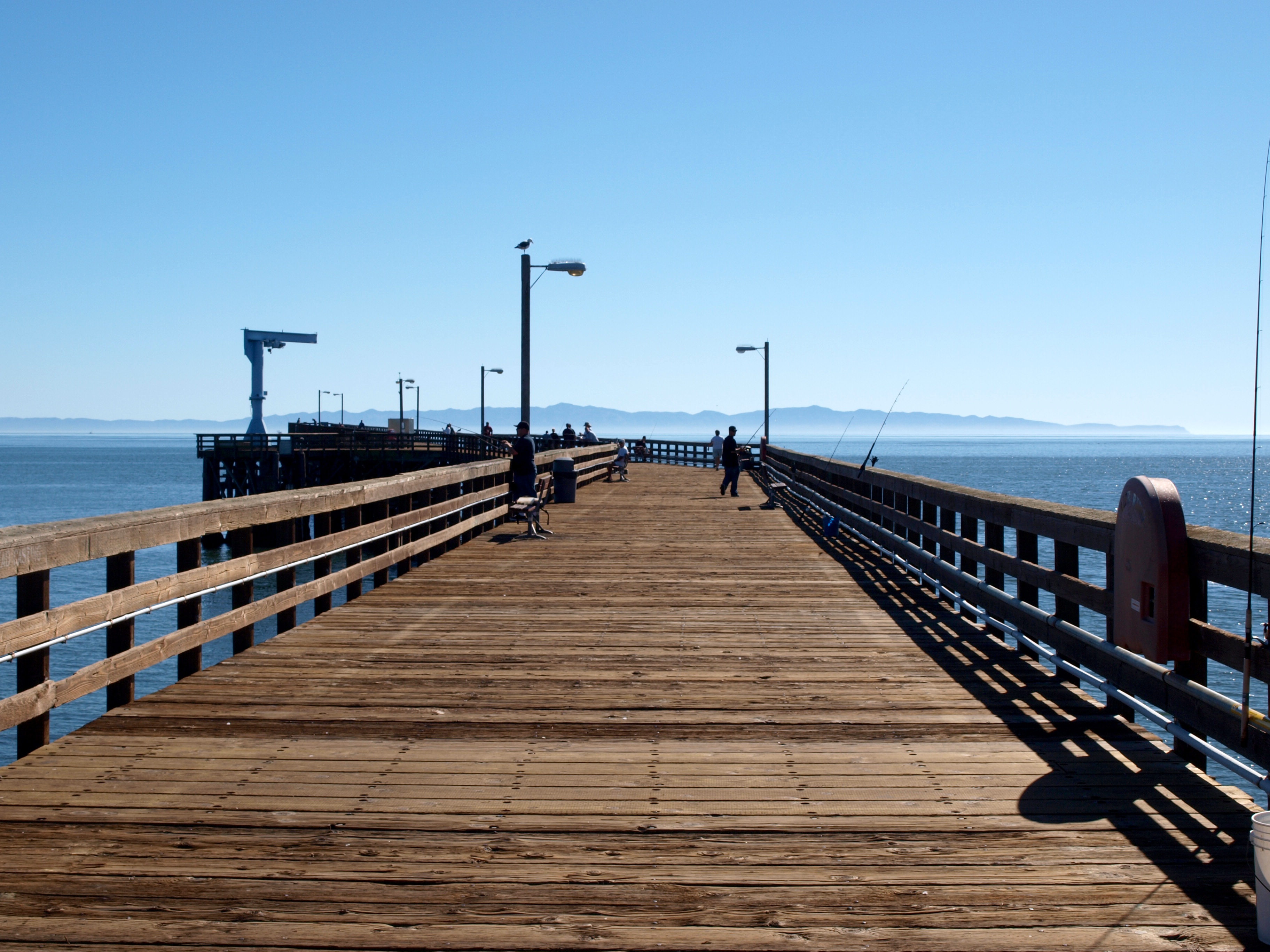
On one visit to this pier, I casually mentioned to a fellow angler that I considered this one of the best piers in California. He nodded in agreement, said he had recently moved from the Los Angeles area, and mentioned that he had never seen the consistent action he had gotten at Goleta. Usually something is biting at this pier and, more often than not, there is an opportunity to catch good quality fish such as halibut, corbina, bass and rockfish not to mention some large sharks and rays. When combined with easy access, good (and free) parking, and well-maintained facilities, there is every reason to include Goleta in a list of the state’s best piers.
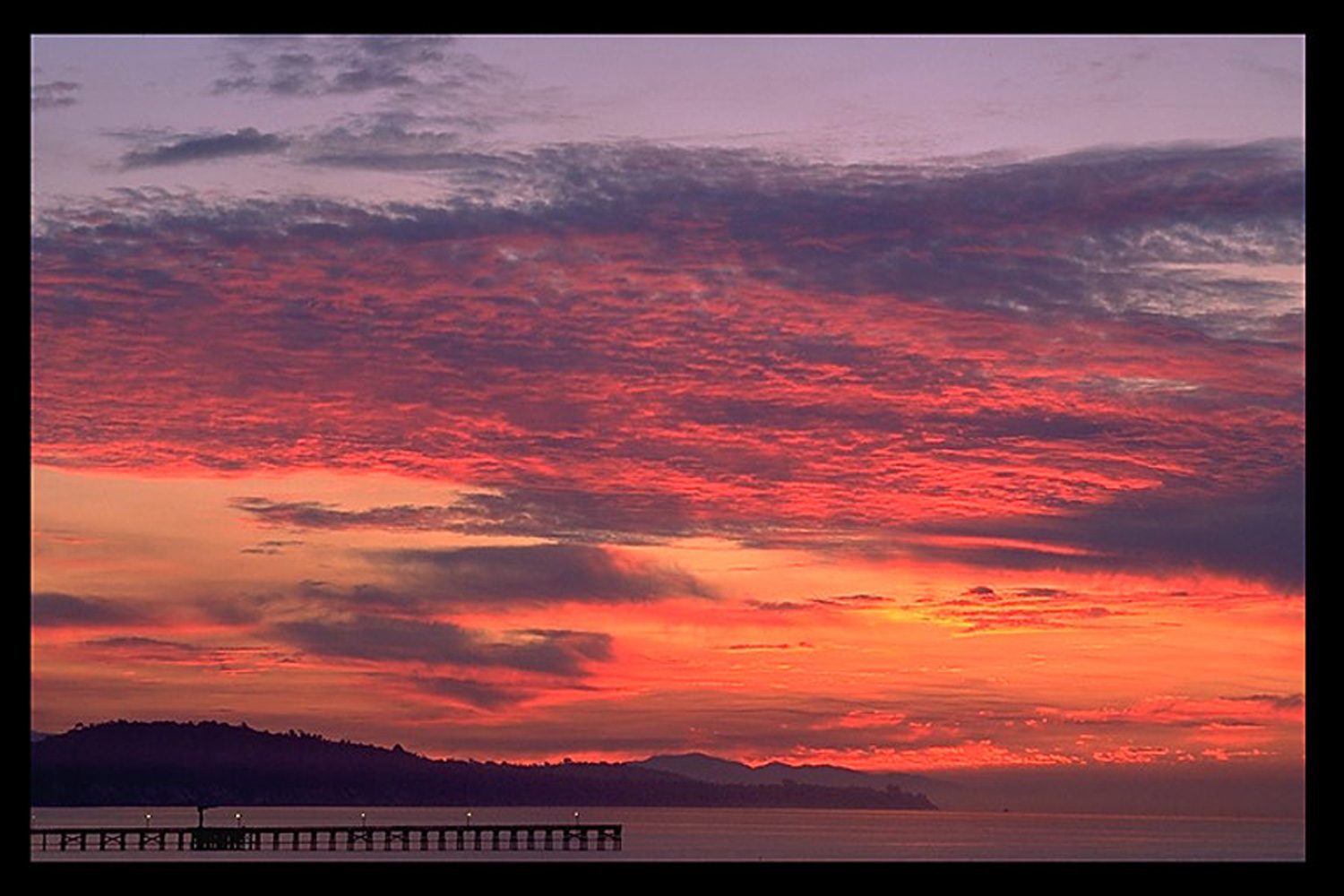
Environment and the Fish. This 1,450-foot-long pier extends out south from the sandy beach of the Goleta Beach County Park, a narrow half-mile-long sandbar that is capped with towering Mexican fan palms, beautiful picnic grounds, and an excellent restaurant. On one side sits the mighty Pacific and Goleta Bay, on the other is the Goleta Slough, one of the region’s major estuary areas. It’s the most popular and visited park in the county.
Just east of the pier is the outlet from Atascadero Creek and Goleta Slough, and many days you can see surf anglers wading out from the outlet in pursuit of surfperch, corbina and halibut. Look to the west, and you’ll see the nearby buildings of the University of California-Santa Barbara as well as Goleta Point.
The bottom here is mostly sand but the pier’s pilings are heavily encrusted with mussels and the sea stars that feed upon them—mainly ochre stars. The mussels also attract perch and a diverse assemblage of smaller species (which in turn attract larger species). The pilings act as an artificial reef—reef #1.
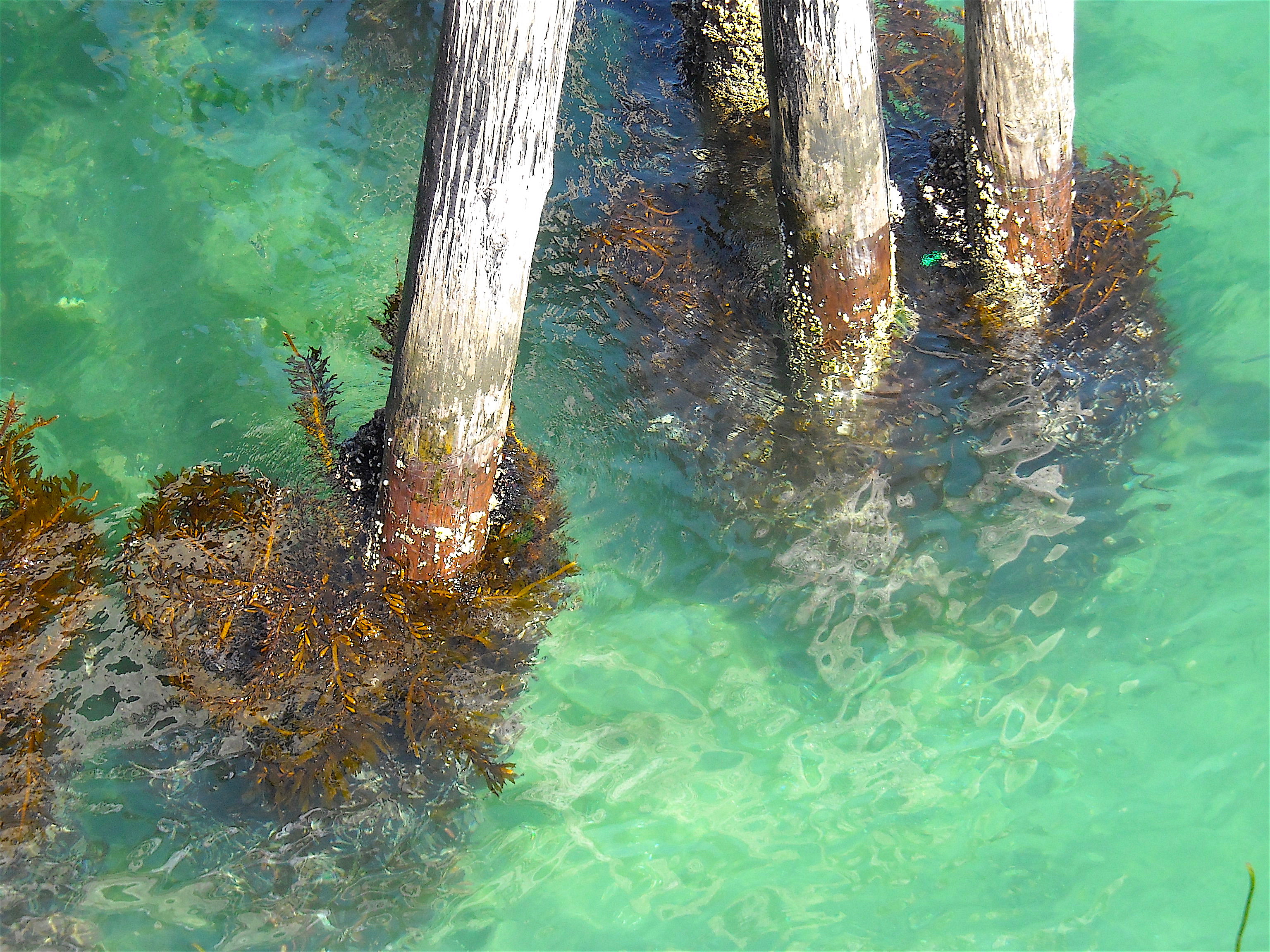
In addition, a pipeline runs parallel to the pier on the right, or west side, roughly 120 feet away from the pier before the bend in the pier, 90 feet out after the bend. This pipeline, and the ballast rocks that protect it, provide a strong base onto which kelp can attach and acts as an artificial reef—reef #2. The name it’s been given by anglers is the “pipeline reef” and it’s usually covered by several species of algae, as well as a variety of invertebrates (although the amount of kelp can vary year to year depending upon water temperature). The kelp provides an underwater forest that serves as a home and attractant for fish (including at least six types of rockfish) and other marine creatures—five types of sea stars, a trio of tube anemone, many different species of crab, and even an occasional lobster and octopus.
Although Goleta Bay itself was once home to a lush and large kelp forest, much of that disappeared in the early 1980’s, primarily due to warm water and the El Niño storms of 1982-83. If it ever regains its former size it will only improve the fishing (and 2008-09 saw a tremendous increase in kelp around the pier).
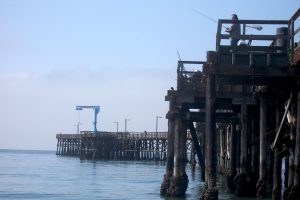
Inshore is the sandy beach, an intertidal area rich with filter-feeding sand crabs and polychaete worms, the favorite foods for the barred surfperch and corbina that make up most of the catch close to the beach. Close by though, and sometimes in surprisingly shallow water, will be found halibut, leopard sharks, guitarfish and thornback rays.
It’s also the only pier where I’ve heard of a black (giant) sea bass being taken in the shallow surf area. The unusual catch, a small, 12-pound juvenile, was taken in June 2002; since then a steadily increasing number of the illegal, zero limit, giant sea bass have been showing up at the pier. In fact, one week alone in 2008 saw four 2-3-foot-long baby bass hooked by anglers. Unfortunately three were kept even though regulars tried to stop them.
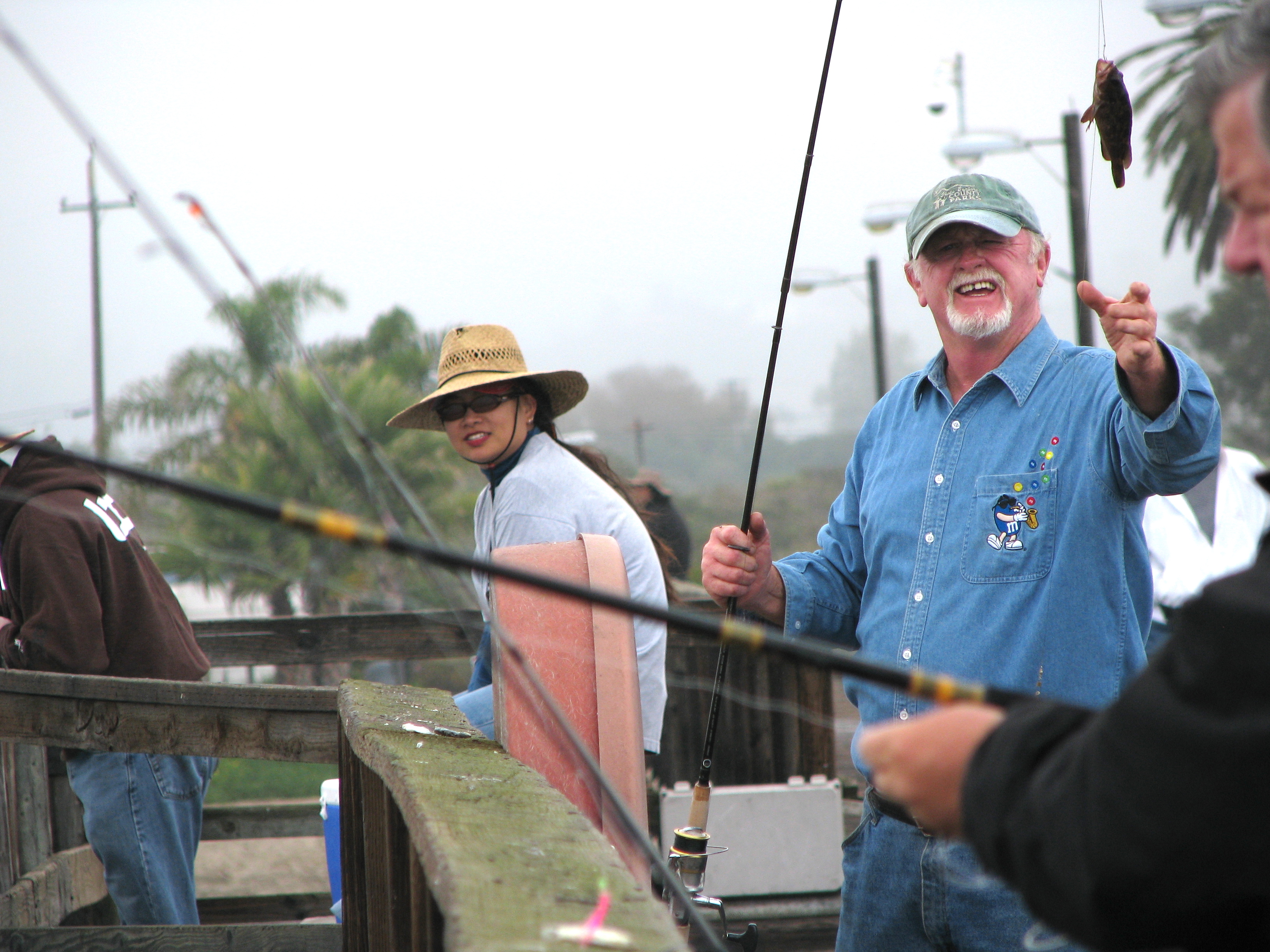
Pierhead (Boyd Grant) with a sbr (small brown rockfish) and KelpAngler (with hat)
Further out on the pier, especially on the east or non-reef side of the pier (an area where sand is the predominant feature) is where halibut become the main quarry. Mid-pier can also see a steady catch of white croaker, jacksmelt, small perch and, depending on the season, pelagics. Mackerel are common and caught in large numbers, while bonito are mainly an El Niño, warm-water year fish. Barracuda sometimes make a showing in the fall while white seabass (usually the smaller ones called sea trout) are an occasional catch May-October. Years past saw a smattering of yellowtail and wayward salmon but both are uncommon and a catch of one will have anglers hooting and hollering and dancing a jig (actually that may be a slight exaggeration).
The reef area created by the pipeline is most heavily populated by sbr (the local term for small brown rockfish) and SBR (yes, the larger, small brown rockfish) but is also frequently home to hungry calico bass (kelp bass), grass rockfish and kelp rockfish. Unfortunately, a lot of the bigger fish are lost as they wrap the angler’s lines around the kelp. As usual, the regulars are the ones who best know the proper techniques and baits, and they tend to catch most of the big fish. However, this is one pier where both expert and novice can usually catch some fish.
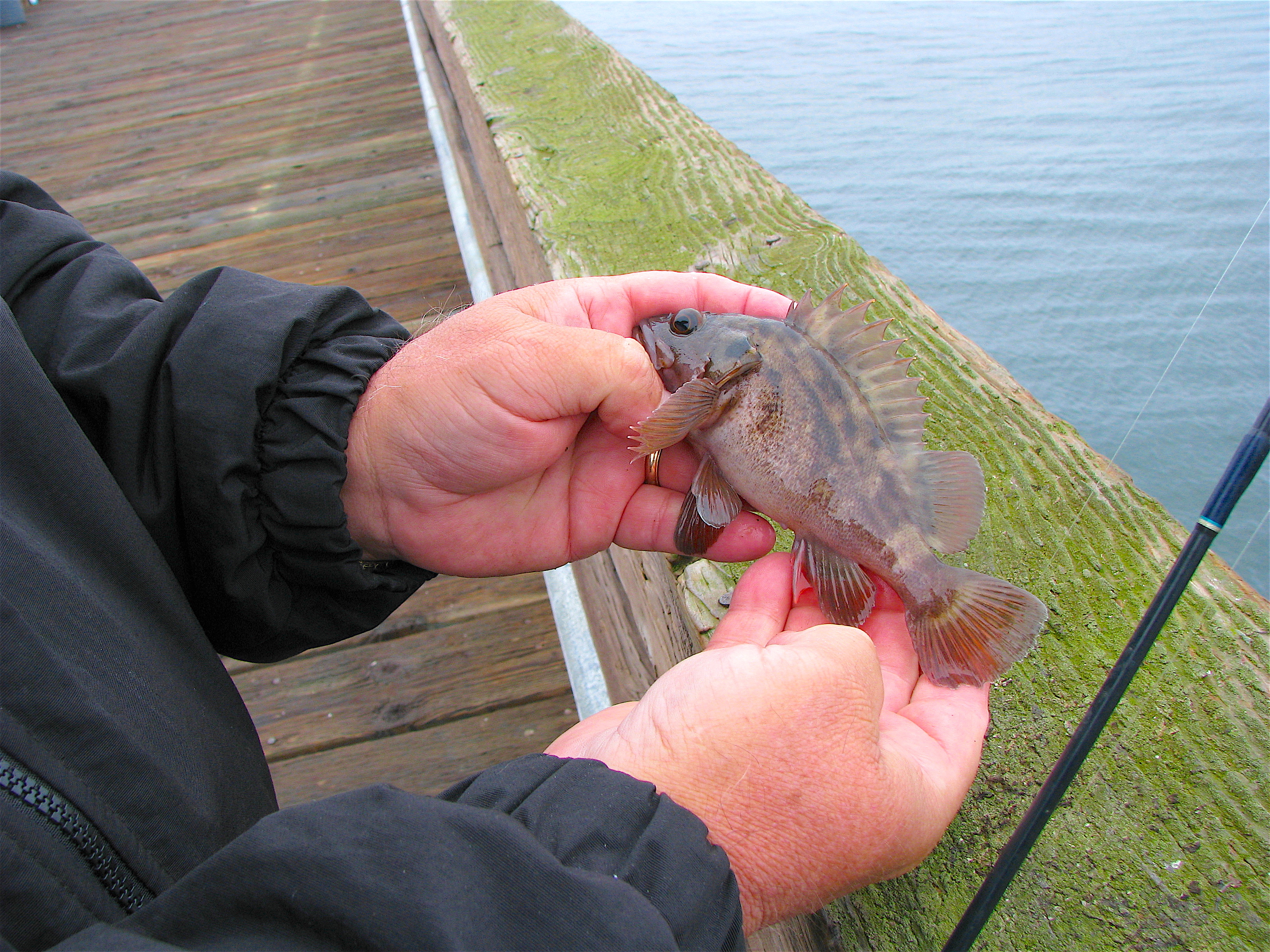
A sbr — small brown rockfish
Unusual fish have included a banded guitarfish (Zapteryx exasperata) taken in April of 2003, a run of deep-sea Pacific saury that visited the pier at the end of August in 2003, an adult blue rockfish in 2002, and a deep-water starry rockfish taken in June of 2010.
In April 2008, a 38-pound striped bass was taken from the pier but it sounded like it was snagged by one of the guys who commonly snag fish in the surf area. The “snaggers” use a heavy rod and reel with heavy line and a leader rigged with six or more large treble hooks. A piece of cloth (usually red) is attached to the leader followed by the sinker. When they spot a fish in the shallow surf area they cast out and snag the fish. There is nothing sporting or ethical about it but technically it’s legal as long as they don’t snag certain sport fish. But they do snag the sport fish and do sell their fish which is illegal. To date, no one’s been able to stop it.
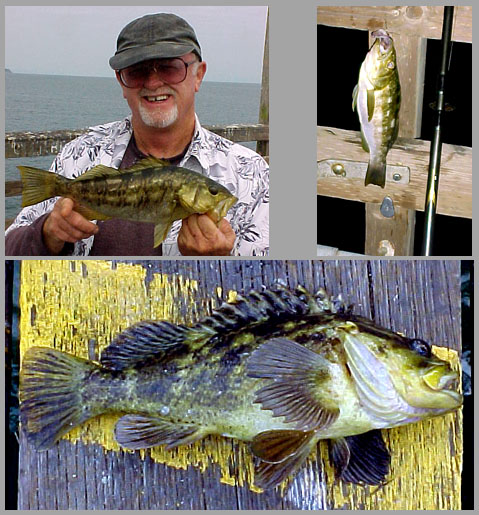
A bass and a rockfish caught by Pierhead
A small run of diamond turbot took place in July ‘09 with most of the blue speckled flatfish coming in around 9-10 inches in length. And though smallish-sized speckled sanddabs are sometimes way too common at the pier, a run of 10-12”-long Pacific sanddab were taken in the summer of 2010, fish that are normally found in deeper water in SoCal. Only problem with both species was the same thing that often happens with small flatfish, some people thought they were illegal halibut and began to throw them back (which at least shows a good intention on the angler’s part). Once again it shows that you need to know what you are catching!
In addition, a baby great white shark was taken in September of 2000. The young shark, only 5-foot-long, was hauled up onto the pier by way of two crab nets and four strong anglers, and then returned to the water after the hook was removed. Since it is now illegal to capture a great white, it was a wise move.
An interesting catch, but not a fish, was a beautiful, yellow-colored, spiny king crab (AKA California king crab) taken in May of 2009. What the normally deep-water crab was doing at the pier is not known.
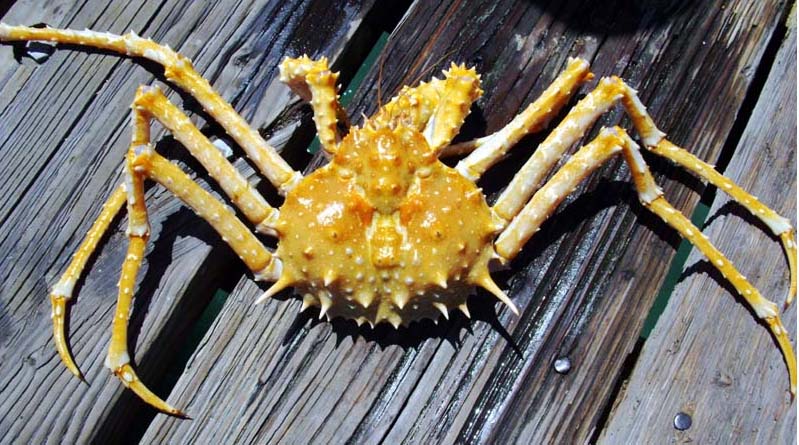
California king crab
The multiplicity of environments at the pier, and the resulting smorgasbord of species (I’ve caught nearly forty different species here), make the pier special and highlight why it’s given a high ranking among the state’s piers.
Although the pier’s listed length is 1,450 feet, lifeguards say it’s 1,375 feet (don’t know why they would measure it); the listed width of the pier is 18 feet, the distance from water to pier surface 24 feet (at mean low water).
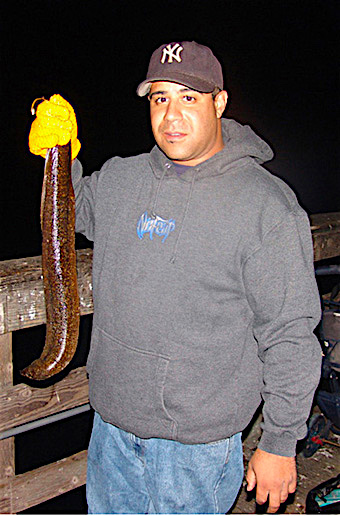
Unknown eel caught by Jessie
Fishing Tips. Bring two rods here; use the light one to catch your live bait the larger one to catch your dinner. Most regulars here try to catch a small smelt, a shinerperch, or brown bait (a small queenfish or white croaker) and then fish these as bait on the bottom for halibut and shovelnose sharks (guitarfish). Use a slider leader or a Carolina-type rigging with live bait attached to the hook.
To catch brown bait, or if you simply wish to catch a few small fish, you can try the following. For queenfish, use a Sabiki or Lucky Lura-type bait rig and simply jig, with a slow up-and-down motion, straight down from the pier, being careful not to tangle in the pilings. Generally, the best area for the queenfish is between the shallow surfline and the mid-pier area. For white croaker (tomcod), use a high/low leader baited with number 6 hooks and a small piece of anchovy. Cast the bait out and start to reel in as soon as the sinker hits bottom. The small croakers will usually hit just as the bait nears the bottom or on the retrieve. Of course, you may latch on to a larger fish with this light outfit but if you do, that’s a bonus.
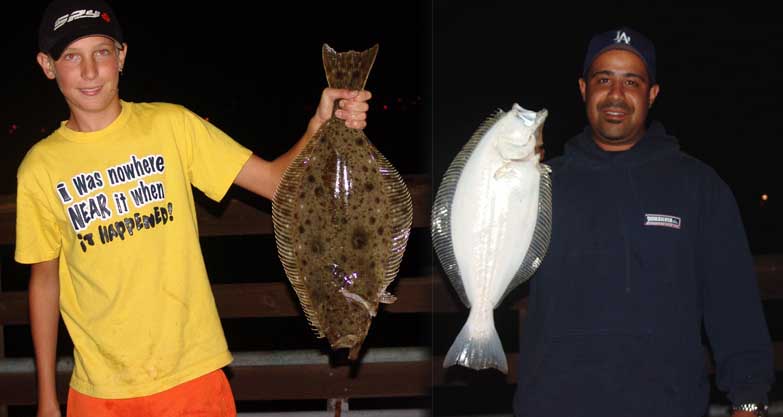
Halibut caught by Jessie
The majority of halibut are also taken in this fairly shallow area, because of the queenfish, walleyes, shiners and other morsels of food they see inhabiting their territory. Since the advent of the pipeline it seems most halibut are taken on the east side of the pier but some halibut will be landed from almost every section of the pier each year. Increasingly over the years more and more regulars use plastics for the halibut even though they aren’t nearly as effective from the pier as when used in the surf or from a kayak. A plethora of brands and colors are available but Big Hammer swim baits, a product manufactured by local angler Pete Wolf, have become a favorite. He recommends the 3-inch red flake and red diamond varieties.
For large barred surfperch (to 15” and more) and some really large corbina, fish the surf area on the bottom using live sand crabs, fresh mussels, or bloodworms. Quite often the fish will be in the shallowest water imaginable but you’ve got to put your bait where the fish are holding. And, similar to the halibut seekers, a sizeable number of perch fishermen seek out the perch using plastics—generic grubs (darker colors, especially root beer colored), 3-inch Berkley Power Bait grubs, small swim baits (a variety), and Gulp! Alive Sandworms by Berkley. Here too the Big Hammer swim baits are popular; try 3-inch Big Hammers in the sea wolf and bleeding mackerel colors.
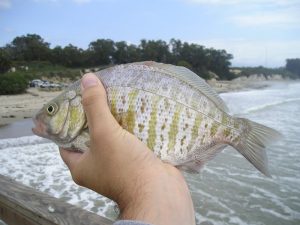
Barred surfperch
Unfortunately this pier, like many, has a population of resident snaggers that target the corbina. Their legal, but unethical catches, makes it hard on those truly anglin’ for the bean-shaped fish. Some locals have called for Fish and Game action against the snaggers (since they often illegally sell the fish) but to date there has been little or no action taken.
For some decent-sized kelp bass (a.k.a. calico bass or checkerboard bass) try by the pipeline reef on the right side of the pier. There are a lot of calicos in the reef and they will often hit the bait just as soon as it begins to drop through the kelp canopy that covers the pipe. In addition to the kelp bass and brown rockfish (numerically the #1 fish), anglers will pull in a sizable number of kelp rockfish together with the other residents of the reef—grass rockfish, gopher rockfish, California scorpionfish, an occasional sand bass, and a few cabezon and lingcod. I’ve personally caught several legal-size kelp bass from the reef, caught a legal size lingcod (March 2004) and caught, seen or heard of several good-sized rockfish taken from the reef (including an 18-inch grass rockfish in January of 2009).
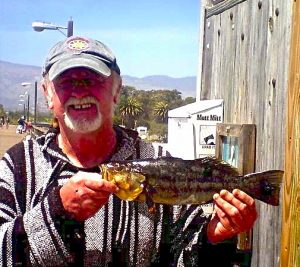
Pierhead and a kelp bass
Although sheephead have frequently been reported by divers checking out the reef, few are landed by anglers. However a trio of 14-17” sheepies were taken on 7/3/10 by a local angler—Robert aka FishFactory—while using fresh mussels. He had taken a sheephead at the pier several years previous while another local—Martin aka Greenrag—had taken one in 2002. Both anglers are generally “perch” fisherman who use fresh mussels for bait. Conjecture as to why so few sheephead are landed primarily concerns the difficulty in landing them from the environment surrounding the pipeline reef. Most sheephead that are hooked would head immediately for the rocks under the kelp so most are probably lost “on the rocks.” “On the rocks” may be a good term when drinking but it’s not a good term when fishing.
I’ve also seen huge schools of sardines hold between the pipeline kelp and the pier as well as thick schools of lazy little lizardfish that seemed to blanket the bottom; more common than either are good old Mr. Bullhead—staghorn sculpin. Also, don’t be surprised if you see anglers fishing in inner tubes or kayaks on the other side of the kelp, it’s become a favorite area for anglers casting plastics for bass along the edge of the kelp. A fish caught early winter 2010 was an ocean whitefish, a species more common to deeper waters and the Channel Islands (although they are a frequent catch from the two piers at Avalon).
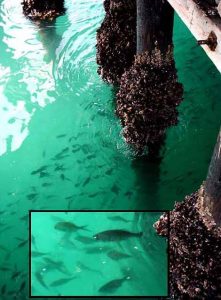
Mussel encrusted pilings and pileperch by the hoist
Two spots favored by locals are (1) mid-pier, near the old Angler Center (now a tackle shop/bait shop), and (2) at the three-quarter point just past the light. Both of these primarily sandy-bottom areas seem to offer good sport for guitarfish; cast to the left of the pier.
Another spot, near the crane, is reported to be good for large perch (pileperch and rubberlip perch), although part of the area is marked no fishing. Fish straight down around the pilings and do not be afraid to let your bait drift under the kelp even if it means an occasional loss of leader. I’ve hooked some really nice perch in the area and seen even larger perch that I was not able to reach (and a 21-inch cabezon was taken in the area in February of 2009). The area between the Angler Center and the crane saw a steady stream of cabezon being captured in November and December 2009 and while most were 12-14 inches long, a 17.5-inch and 18-inch fish were included in the mix. Some of the cabbies were taken by anglers casting out toward the reef, some were taken fishing straight down around the pilings, and most of the cabs were taken on either fresh mussels or squid
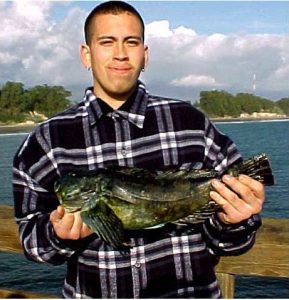
Decent-sized cabezon
The end area, just like on most piers, is generally the home of the pelagics and seems to receive the heaviest pressure from anglers. Most common are Pacific mackerel and when they are running almost any bait and rigging will work. Many people use Sabiki or Lucky Lura-type bait rigs but it’s a good way to see an expensive rigging twisted into a useless mess. Better to simply put a couple of size 4 or 2 hooks on your line and bait with a small piece of mackerel. If the fish are touchy, use a small piece of tapered squid on a size 4 hook at the end of your line with a split-shot sinker up above (if it isn’t too windy).
What about the bigger fish? Bonito have made a comeback in southland waters these past few years but not too many make it north to Goleta (maybe a third of the years). For the boneheads the best rigging seems to be a Cast-a-Bubble or golf ball followed by a splasher feather.
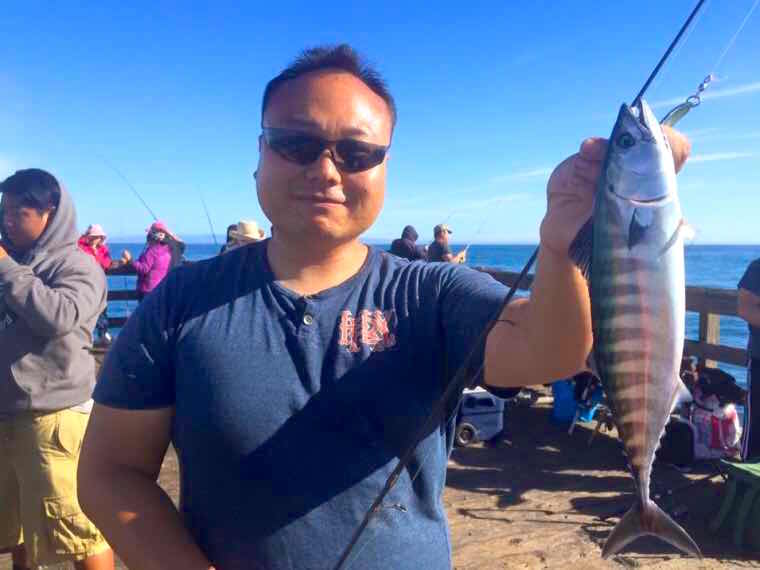
Bonito caught by seabass seeker
Yellowtail, although once a commonly seen fish in the fall (September-October), are rarely seen today. However, if they do show up, live bait (especially a small Pacific mackerel or jack mackerel) fished on a sliding leader will work best. Barracuda are also rarely common but when and if they do show up (usually September-October), most are caught on live bait fished near the surface or on artificial lures. Shiny spoons like Kastmasters or Krocodile are long-time favorites that produce fish; they’re especially effective at night. As for white seabass, like the other biggies, they are relatively uncommon although an occasional fish will be landed (including a 40” fish in July ’08).
Goleta is a pier that sees a steady stream of regulars out most nights in pursuit of sharays—sharks and rays. For the sharks, the end area is generally the hot spot. Fresh mackerel and sardine seems the most common bait for the sharks. Squid is the preference for the small thornback ray as well as the larger bat rays, shovelnose sharks (guitarfish), and big skate (that occasionally make an appearance).
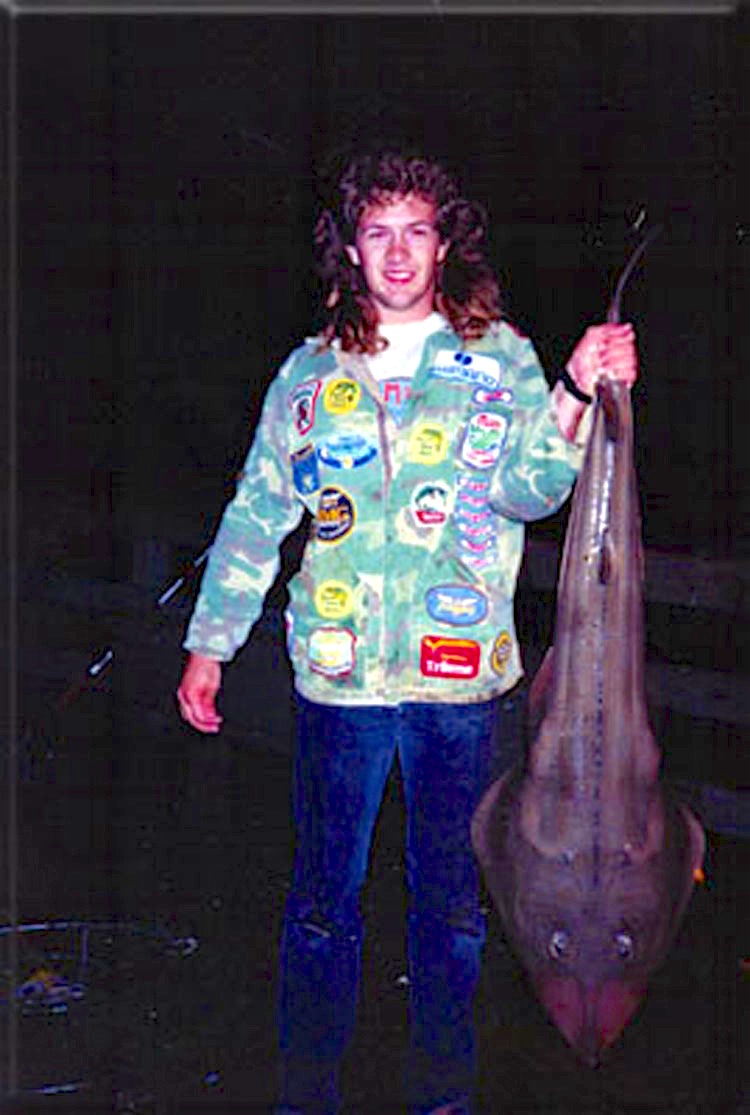
Shovelnose shark (guitarfish) caught by a young Leapin’ Bass (Pete Wolf, owner of Big Hammer lures)
Most of the sharks that are caught are smoothhounds, leopard sharks, or spiny dogfish but you’ll also see an occasional swell shark (often mistakenly called leopard sharks by locals), horn shark, or angel shark. Most of the sharks are small to mid-size but not all as seen in the 60” leopard taken in June of ’08 and a five-foot-long soupfin shark taken the same month. October ’09 saw a run of good-sized sharks including four large threshers, a 90-pound soupfin, and both a six-foot and eight-foot-long 7-gill. Just a short time later, December ‘09, saw another 7-gill, this one a seven-foot, nine-inch fish. In August of 2010 a 40-pound angel shark was landed. Once in a blue moon someone will latch on to a blue shark (a good fish for a blue moon—and a 48” blue was taken in June of 2002), or even a great white (as mentioned above).
Both bat ray (mud marlin) and shovelnose guitarfish are common and both can reach impressive size. Shovelnose to nearly five feet in length have been landed and give a good, strong, spirited fight. Often the heaviest fish taken at the pier will be bat ray, the big old mama bat ray (all the big ones are female) and most years will see fish that are close to or exceed the hundred pound mark. The fights can be very long and hard with the fish dragging the angler up and down the side of the pier before the final capture (if the fish isn’t lost to the pilings) and the drop of a hoop net. There’s a reason why their nickname is mud marlin! Luckily more and more anglers are returning the mamas to the water so they can continue to populate local waters with young ‘uns.
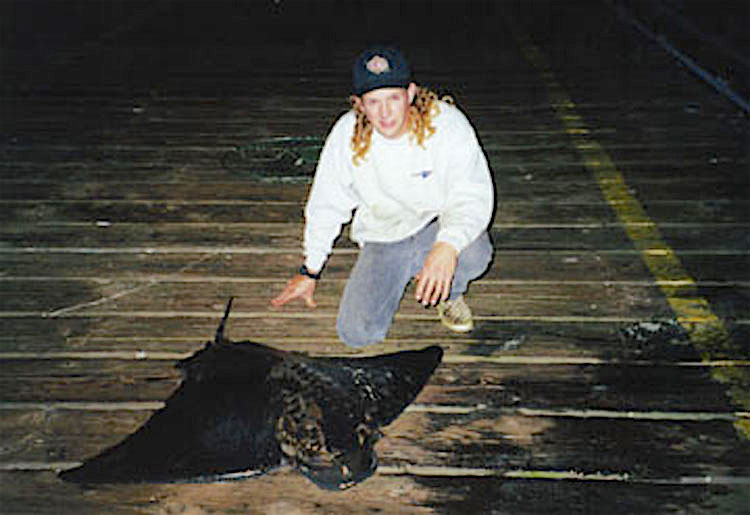
Bat ray caught by Leapin’ Bass (Pete Wolf)
Do not, repeat, do not, simply cast out your line and let the bait sit on the bottom. Not only is this not the best way to catch fish, but this is also a pier that sometimes sees heavy infestations of starfish (oops, sea stars). The interesting creatures (and here they’re typically the small, purple-colored sea stars) like to grab hold of baits sitting on the bottom. Check your bait often and make sure the probing, gnarly, purple foot of a sea star doesn’t encircle your hook or sinker.Don’t be too surprised if you occasionally see a truly gnarly looking creature—an ugly old spider crab (sheep crab). Although perhaps not as common as at the Port Hueneme Pier or Stearns Wharf, they are still the main “crab” catch at the pier followed by an occasional red crab or yellow crab. Also don’t be too surprised if you bring up a lobster; they’re not as common as piers to the south but enough are seen to keep it interesting. Do make sure you do not keep any lobster caught on a hook (you have to have a hoop net) and be sure you have a lobster card if you intend to use a net to seek out the bugs.
Lastly, be sure to follow the rules! The following story is taken from the web sites July 1997 Report Page: “A Fish and Game officer, in plain clothes, apparently did a little sting operation at Goleta last week. First he watched the fishing action for a while. Then he put his badge on the front of his shirt and approached an angler. How had he done? No fish was the reply. The officer then asked to see inside the man’s backpack and lo and behold there were three undersized calico bass (kelp bass) and one undersized halibut. The officer wrote out a ticket, which the man then proceeded to rip up and throw into the water. He followed that up with a few choice words that cannot be printed in this G-rated site. Ten seconds later the man was handcuffed to a pole, the sheriff was called, and shortly thereafter the man was issued tickets for four illegal fish, polluting the water, and resisting arrest. DUMB, TRULY DUMB!”
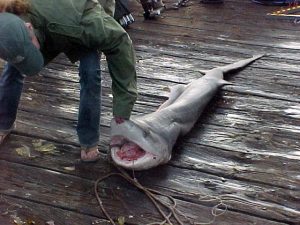
7-Gill shark caught in 2009
The Pier Rats Speak — Reports and advice from the Pier Fishing In California Message Board — pierfishing.com (Edited)
Date: September 20, 1997; To: Ken Jones; From: Boyd Grant; Subject: Report
Ken – Good news! The halibut are finally biting at Goleta and Gaviota. I’ve caught 15 since mid-August … landed a 4-pounder at Goleta last Tues. evening (after losing a 10 lb+ at Santa Barbara on Sunday because I didn’t bring my net). The biggest one caught at Goleta (two weeks ago — not by me, unfortunately) was 28″ and there were unverified rumors of another over 20 lbs! All are caught mid-pier. One of the rangers at Gaviota told me that Ron (another staff member?) landed a 34″ Halibut fishing from the end of the pier using a whole (8-10″) live mackerel two Sundays ago.
I’ve had great success dragging the bottom less than 20′ from the piers — I use frozen anchovies snout-hooked to a 2/0 live bait hook tied to the end of 20# test and weighted down with a small split-shot (1/4″ – how do you measure split-shot?). I cast to either side and let the bait settle to the bottom… then I bring it up several times and let it settle back down before finally dragging it very slowly (4-6″ per second). I hold the pole balanced in my hand and have to be extremely alert to when the bait is picked up — if it meets with some resistance I stop dragging and wait for the line to start pulling away before I set the hook. Works like a charm! But it is such an intensive effort that I usually only fish the hour before and after the tidal high. The advantage here is that (unlike still fishing with dead bait where, if you catch one at all, they swallow it all the way down making it somewhat difficult to extract from a short without severely injuring the fish) it generally produces a fish hooked through the side of the mouth which can be released without hardly any damage at all.
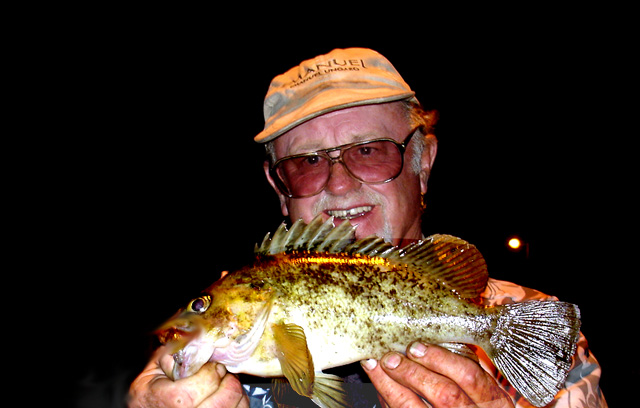
Pierhead with a grass rockfish
But the biggest thrill of all was a 6-lb, 24″ white sea bass (at first I thought it was a giant croaker)! I have never landed a harder fighting fish in my life … it was really heart-breaking having to return it but I didn’t think that even standing on it could stretch it to the legal 28″ (even though there were several people who had suggested it). In the future I am going to arm myself with a Polaroid so that I can at least capture them on film.
The El Niño is producing some interesting effects here — one night I caught a 12″ octopus and a 16″ mackerel. The young lady next to me caught a 10″ Pacific lobster. Shark fishing appears to be picking up as well, on Tuesday I helped land two 4′ smoothhounds and I have caught 5-6 30″ shovelnose. My brother caught a 16″- 3.5# kelp bass at Gaviota and I continue to catch at least several legals each trip to Goleta. Boyd
Date: January 10, 1998; To: Ken Jones; From: Robert K; Subject: Great site!!
Surfing the web for months, I had failed to search for a site on pier fishing. It had never crossed my mind to find pier fishing info. on the web until today. Me and my buddy, who told me to search for this site, fish anywhere and anytime we get a chance. We have fished just about every pier in so. Ca. and a few in central and no. Ca. but we usually stick to the ones that we’ve had our best luck on (Gaviota, Goleta, Port Hueneme, and Malibu when it was open.). I used to have to look in ten different newsletters and magazines to get a report on the ocean and try to apply it to what the pier would be like. Now, I can see updates on my favorite piers quick and easy. I also keep a copy of your book rolled up in my tackle box when I go fishing.
I am primarily a shark and ray fisherman when I go to the pier (for fun, not for keeps) and I have concluded that Goleta Pier is one of the best piers around. There’s nothing like a bat ray going for its initial run or a shovelnose digging its nose into the ground trying to resist your pull. On Goleta you can have it all. We always fish far out even though large halibut are often caught in the shallows. We always cast one line out into the kelp which grows on the pipeline which parallels the pier about 30 yards out. Here we almost always catch a few kelp rockfish and other types including occasional sand bass, calico bass, and scorpionfish. When the fishing is slow we fish mid-pier by the crane for perch which can run pretty big at times. At the end we catch mackerel and smelt for bait during the day and at night we put them to use for sharks. My best catch on Goleta was a 4-foot by 4-foot big skate which is not very common in So. Ca. It broke my little hand scale which measured up to 50 lbs. My buddies best catch was a shovelnose shark which was little over 6 feet and also tipped my hand scale over the max. It was the biggest guitarfish I had ever seen. One local told us to get it checked out to see if it might have been close to a record fish. However we had no cooler and live over an hour away from the pier so we decided to take a few pics and let someone else get the chance to catch it. Keep up the good work, Robert and Demetri — “pier rats”
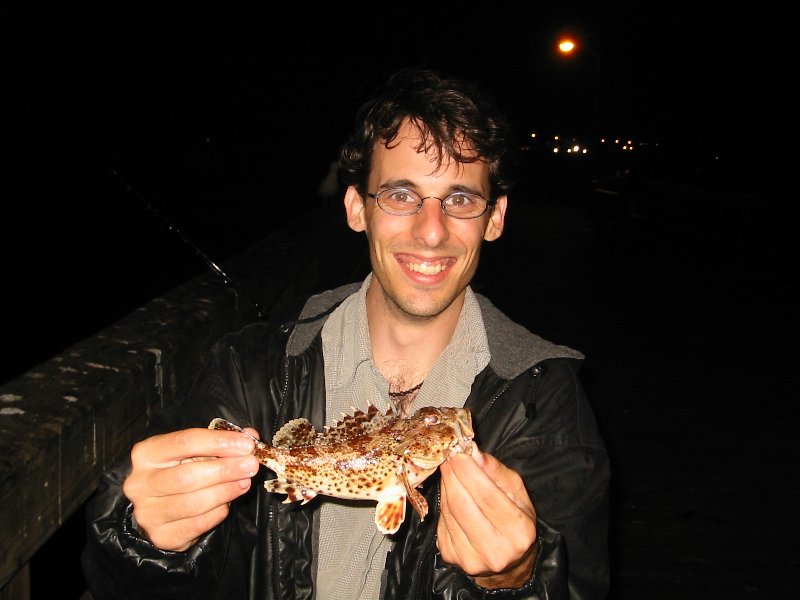
Baby scorpionfish caught by SteveO
Date: January 10, 1998; To: Boyd Grant; From: Ken Jones; Subject: Goleta Pier
Boyd, Thought you might like to read the attached message since it concerns your favorite pier — Goleta. What do you think? Also, if you would like to contact him let me know and I can check with him to see if he wants to give his address out.
Best wishes, Ken,
Ken, Thanks for passing Robert’s message on to me — sounds like he knows the Goleta Pier pretty good.
I agree with his descriptions of the hot spots.
The pipeline is to the west of the pier (on the right going out looking directly across to UCSB). The two best places on that side are mid-point across from the restrooms and at the three-quarter point next to the light. My all-time best was at that point one late morning in 1989. Within two hours I had caught three 10# shovel-noses.
But the trick is to cast out as far beyond the kelp as possible (I think there is substantial sandy bottom there). I use a 10′ surf rod and 3-4 oz of sinker. Not easy to do because you’re casting directly into the prevailing winds. But when the wind permits and the sea is glassy then it’s almost a sure thing.
A lot of kelp bass just above the pipeline — bait gets nailed just as it starts dropping through the canopy but it’s hard to keep them from wrapping themselves in the stalks. Took a 3# calico there last spring.
Was at Goleta for 4 hours last Monday — five 12″ thornbacks. Felt like I was fishing in a nursery. For the last two trips out, on practically my first cast, something big has picked it up and then started to slowly move parallel to the pier until the line snapped (had the drag set too tight – 20# test.) Didn’t act like it was hooked or anything — rather like it was just moving on anyway. Didn’t see any seals in the area — wonder what it might have been. Later, Boyd
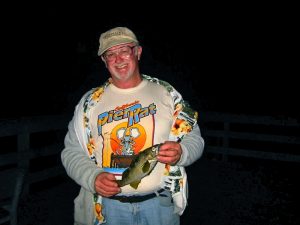
Pierhead and a sand bass
Date: April 6, 1999; To: Ken Jones; From: David S; Subject: May Pier Report – Goleta
Hi Ken! I’m having a blast, catching fish and dreaming up new rigs. Here’s a little report while it’s fresh in my mind. I’ll try to add a couple more to be merged at the end of the month:
The kids had been catching about 20 silver perch (walleyes) per hour on Lucky Lura jigs. Mostly from the second-quarter of the pier. Enough that the warden came out (after the wife and kids had gone home) to count up my fish. He wasn’t satisfied when I showed him my 17 keepers. He had been watching us for hours with his binoculars and said, “There’s no way you threw back all those fish, I was watching you the whole time.” He accused my wife of taking a bunch when she left. I laughed, “they didn’t even carry their own poles back, let alone any stinky fish to be cleaned!” Anyway, that seems to have slowed down a little. Now I’m seeing lots of good sized barred surfperch (2-3 lbs.) being pulled in from behind the surf. Typical high-low leaders with medium sinkers and, what else, fresh mussel! Took a trip to the end of the pier at sunset last night to see lots of angler action. The most impressive was some 11-year-old kid pulling in 9″-12″ mackerel — three at a time!!! We caught a few of our own along with 6 white croaker, all ranging 9″-11″. We used squid on snag lines with enough sinker to cast out but keep off the bottom as we retrieved. Interesting note, nothing was being pulled off the west (kelp) side of the pier.
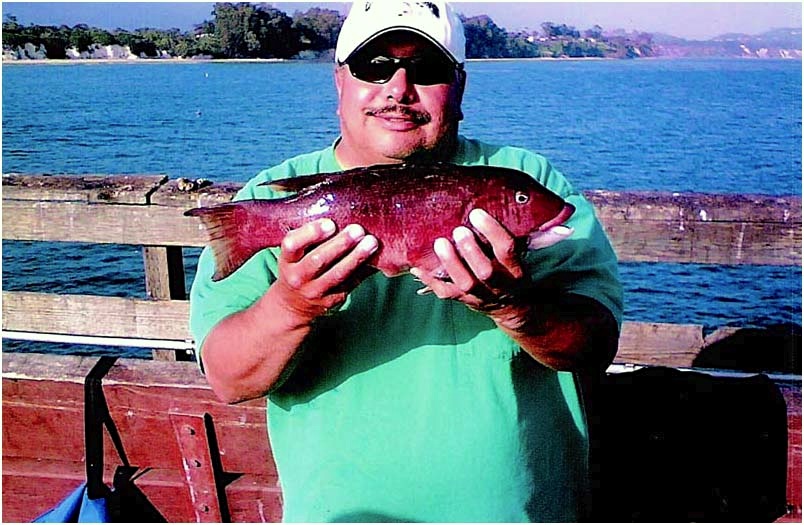
Sheephead
Date: June 30, 1999; To: Ken Jones; From: David Strong; Subject: Monthly Report
Hi Ken, Here’s your monthly Goleta Pier Report: Halibut seems to be on everyone’s mind. The bite has been good and from what I hear, many have been caught. I only wish I could speak from experience! All of the anglers are working the bottom in search of the tasty flat stealth and they are catching plenty… shovelnose shark?!? You got it! Mixed in with some thornback rays and other bottom undesirables. I’ve caught plenty of flat rays/sharks myself this month and even saw a fellow angler pull up two on one line. Common size is 18 to 24 inches. I hooked into one that was about 4 feet, but lost it in the pilings when I had a (gag) tourist hang onto my rod while I went for the landing net. Note to self: never hand off my rod to anyone! Early in the month we had one of those ‘clear water days.’ Visibility was a good 6 to 8 feet down — just like an aquarium. I spotted a barely legal halibut, a 4-foot Leopard Shark and tons of huge Perch (1-3 pounds!) picking at the pilings below. Anglers were frantically dropping lines in their midst’s, but the fish wouldn’t have any of it. I guess they got to be that big by sticking to the pilings for food, not trusting the
easy pickings jiggling curiously just a few feet away. Before I make a joke about fish in schools, I’ll just stop here…
Date: July 4, 1999; To: Pier Fishing in California Message Board; From: Carl Carillo; Subject: Salmon at Goleta
This morning a 28” Salmon was caught, according to Ranger Dave, on an anchovy! Anyone using floats or bobbers to suspend bait off the bottom and using the current and wind to cover larger areas than casting? Burnt drags! Carl C
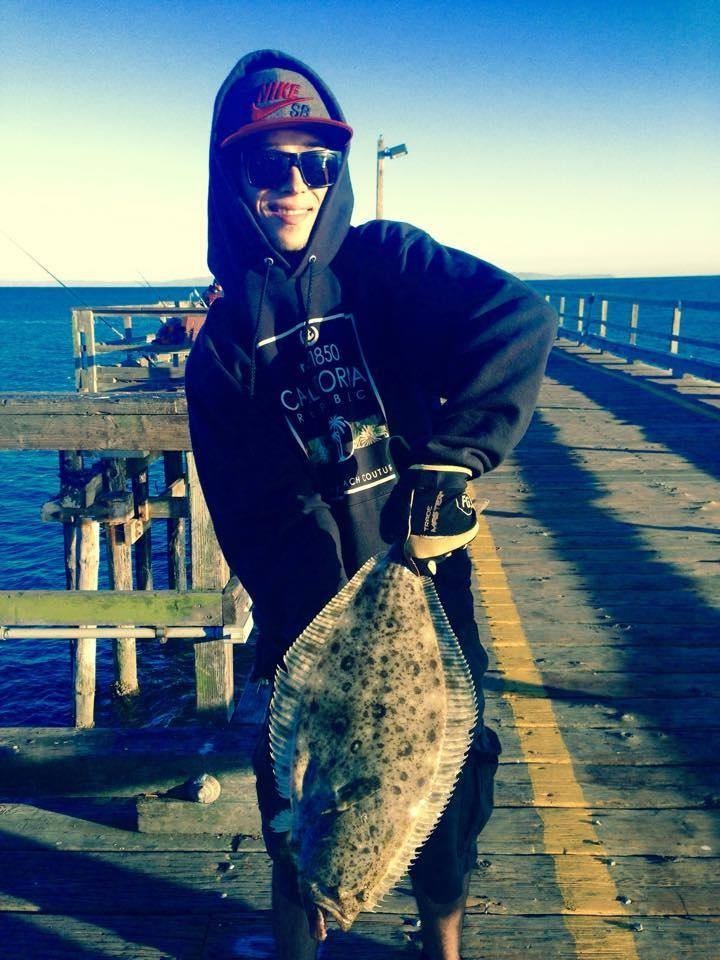
Halibut
Date: September 22, 1999; To: PFIC Message Board; From: Kanamit; Subject: Goleta
Matt, I’ve been fishing on the Goleta Pier (a few miles north of Santa Barbara) for almost 20 years. When I first started fishing there I primarily targeted halibut. The most enjoyable way to catch them is on plastic swim baits but this is not the most productive. Live or dead anchovies work good. You can get a snag line and catch live bait (small mackerel, shinerperch, etc.) Fish like Bonito and Yellowtail show up during El Nino years but I haven’t seen them in a while.
For the past 12 or so years I’ve been concentrating on sharks and rays. You can catch them day or night but a lot of the shark species are caught better at night or on a very overcast day. Squid is very good bait but it tends to be stolen quite often from by little fish. I usually try to catch Pacific or Jack Mackerel either on a snag line or a single size 6 or 4 hook baited with squid or mackerel. Then cut them into chunks and use them. Sometimes fillets work well but you may have the same problem with the little fish stealing your bait. The chunks tend to solve this problem.
My rigs are 15-25 lb. line (most people go heavier but I really don’t see the need—I caught my biggest ray on 20 lb.). I tie a 2-3 oz. sinker (pyramid) on about 4-5 inches of line and then to a barrel swivel. I then thread a small plastic bead on my main line, then thread the other loop of the barrel swivel that the sinker is attached to, then another bead, then tie another swivel, then tie my leader (usually 50 lb. test about 18-inches long) to the other end of that swivel, then a 3/0 to 6/0 hook. Cast out, let the line freespool until it hits bottom, set the rod down, take up the slack, and set the clicker on the reel (loosen the drag if you are using a spinning reel). I always set my rod down so that it’s resting on one of the guides, this allows the line to flow freely when a fish takes it instead of your line being pinched between the pier and your rod blank. Some people disagree with me about this because it may damage the guide but I’ve been doing it for 20 years and have never had a problem.
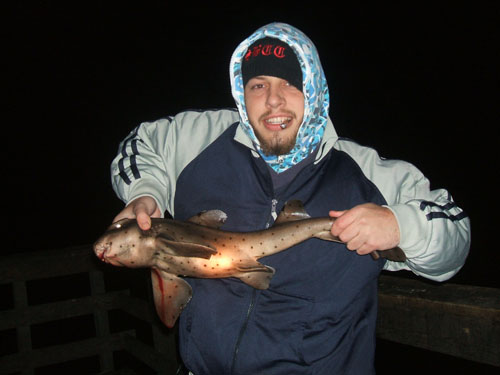
Horn shark
Date: October 8, 1999; To: Pier Fishing in California Message Board; From: Kanamit; Subject: Goleta Pier
Bait: A nice abundance of decent sized Pacific mackerel. But once again the bait rigs weren’t working. Fly-lining pieces of squid was the key. People were really getting upset around me because I was catching them left and right and no one was getting anything. I even showed them my rig when they asked but for some reason they wouldn’t part with their 18-hook rigs. I brought along my tiny 4.5-ft. ultra light G. Loomis with 4-lb. test which made the mackerel a lot of fun to catch.
Sharks and Rays: Didn’t see a single shovelnose but lots of thornbacks. Caught 1 smoothhound, 3 swell sharks, and who knows how many thornbacks. At midnight I finally caught my first ray in quite a while. I caught it on a rod I just got finished building — what a way to break in a new rod. The ray had a 52-inch wingspan and was caught on 20-lb. test using squid for bait. It took four of us to hoist it up the pier — I need a larger rope for my net. The ray was released in good shape.
Date: April 20, 2000; To: Pier Fishing in California Message Board; From: Mike Gray; Subject: In reply to question by Leapin’ Bass
Me and my buddies Scott, Matt, and Glenn, saw a mako tear through a school of mackerel in March of this year. This mako was estimated around 6 foot, a juvenile. Potential to be caught? Yes, when they are around. Scott caught a juvenile 4 years ago and released him. They are a rare sight, of course, but potential is there, even though limited. Matt caught a baby blue around 5 foot last year on a summer night. My co-worker John got a thresher last year as well as in the summer. The thresher was caught in the morning around 8:30 am. Tasted so good. All of us fish for sharks until we are the last one’s on the pier. I am trying to earn my stripes. I’ve got a way to go.
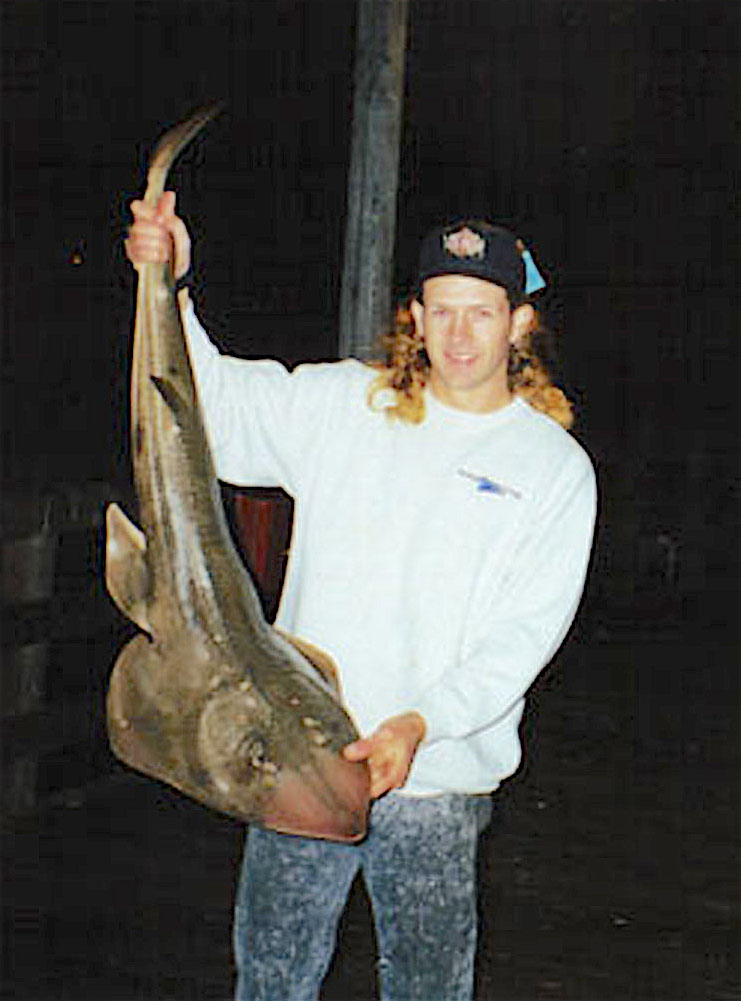
Shovelnose caught by Leapin’ Bass (Pete Wolf)
Date: May 24, 2000; To: Pier Fishing in California Message Board; From: pat papa; Subject: Goleta Pier
Fished Goleta Pier from 5-10 PM. The bait fish (mackerel, smelt and sardines) were more than plentiful. For about two hours there were so many on the surface it was as if it was raining. I have never seen anything like it. The largest concentration of bait was from the middle to the end of the pier. Fished plastics towards the front of the pier for a few minutes without any hits, however someone next to me said they had gotten three halibut all of them short but returned safely. After catching some bait we targeted sharks at the end of the pier. What a night. We caught two large shovelnose, both over 45″ and a couple of smoothhound sharks. All fish were returned unharmed (barbless hooks).
Posted by cojo_reef on May 25, 2000
I know all too well about the mackerel at Goleta. Congratulations. Goleta for me has been hit/miss the last three weeks. Did you catch your sharks on the right corner of the end of the pier or just straight out? That seems to be the best spot at the end of the pier. About 50 yards off the end of the pier is a horseshoe shape U that drops off into deeper water. This is the spot that holds sharks, rays, and skates (bait stealers). Just off the right side of the end an oil pipe is just on the ledge of this horse shoe and makes a deep drop off. On the end of the pier-right corner side, I have seen caught and have caught species from shovelnose shark, smoothhound shark, rays, puffer shark, leopard shark, cabezon, kelp bass, octopus, and huge spider crabs. This one little area holds so many species. When they come in or out to feed they always seem to visit this same spot. Have you noticed this too? You must have caught your sharks from 7:00 PM-9:00 PM. Am I right?
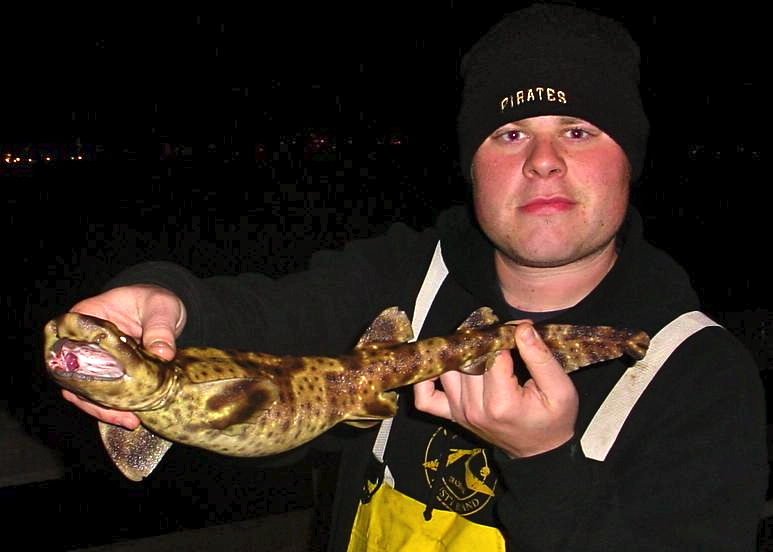
Swell shark caught by DompfaBro
Posted by pat papa on May 25, 2000
We fished to the right at the end and also straight out and caught the shovelnose in both locations. It was nice because there was nobody at the end which is unusual. I agree that this seems to be the hot spot. Last year we would fish Goleta 2-3 times a week but it was usually so crowded that we would fish at the second or third bench from the end. We usually got less fish but would usually get a couple. I would rather catch one or two and not be elbow to elbow. Where do you fish for leopard sharks? I have heard that its better fishing closer to the surf using sand crabs but have not tried it. I have only seen one caught from Goleta between the portacrapper and the crane. It was huge, probably 4-5′ with large girth. What an amazing fish. As a side note, when I was talking to that guy that caught the leopard shark he said that he had seen a large shark surface which was about 10-12′. I guess that is not so common.
In terms of the time period, from what I remember last year, we got most of our bites were after 9 PM till about 11 PM, but you are right this time all fish were caught by 8 PM. Last year we started later in the summer, around the end of July, so maybe the time period has something to do with being later into the summer.
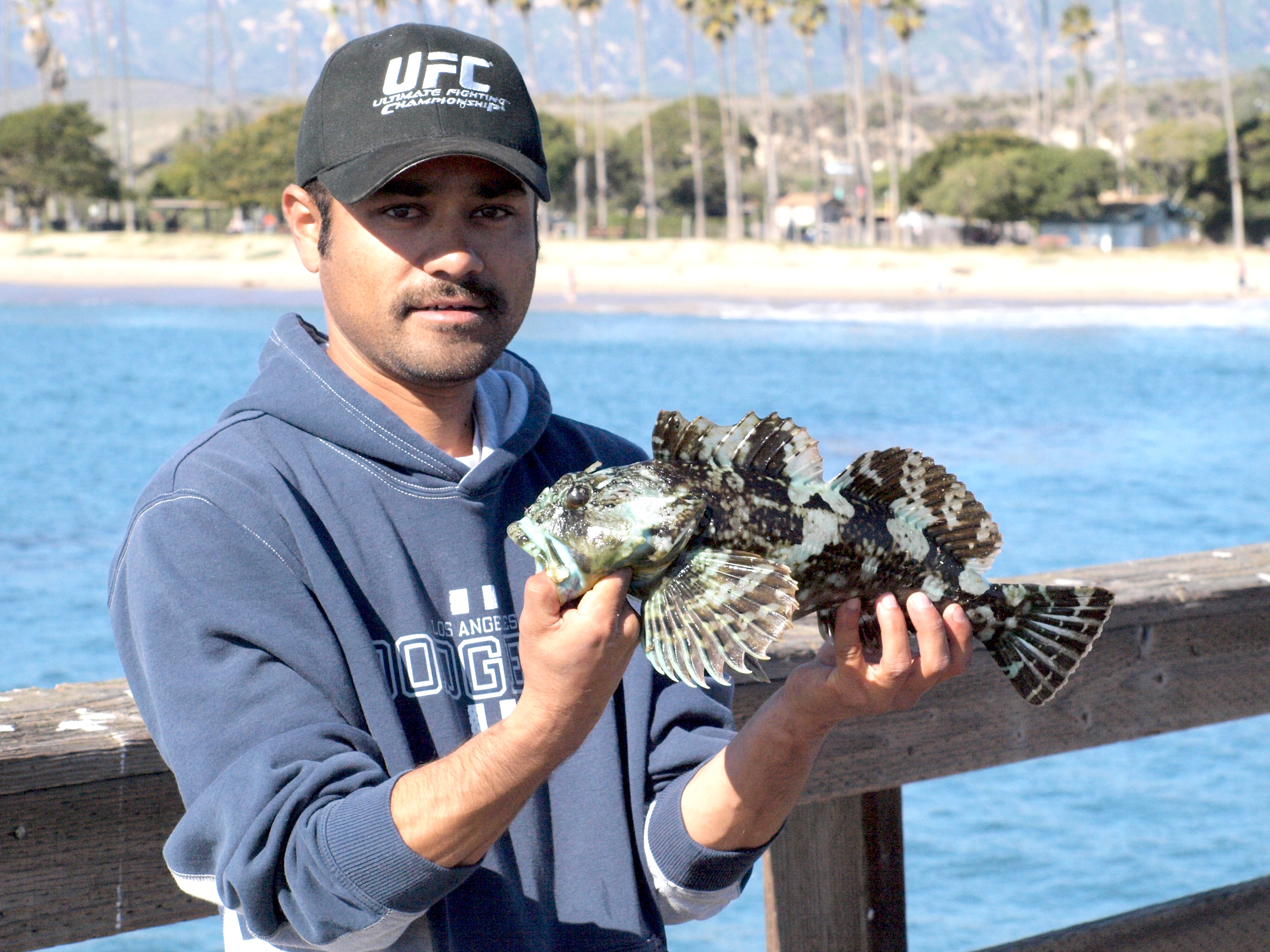
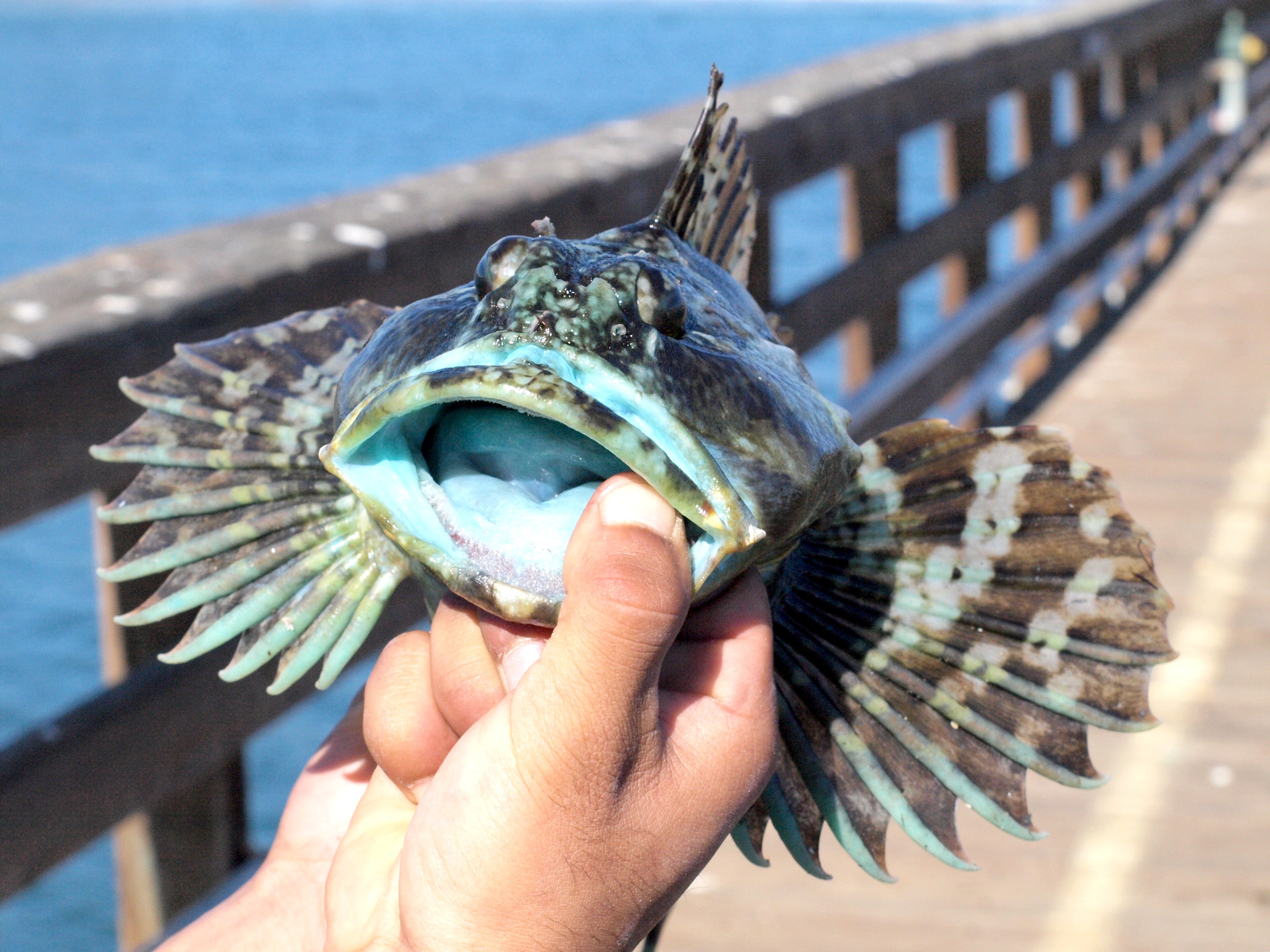
Cabezon
Posted by Leapin Bass on May 25, 2000
I’ve only seen one leopard caught at Goleta also but it was off the left end — caught by my cousin at about 2:00 am. It was a nice one (about 5 ft.). I hear a lot about leopard sharks being caught there but I believe a lot of them are swell sharks. I have caught quite a few when I used to surf fish with bait (now I only use plastics because it’s much more fun and you catch more halibut). You’re probably right about the leopards being in shallower water.
In September of 1984 two blues came close to the pier. One was about 6 ft. and one was about 9 ft. (they looked more like 10 and 13 ft. — everything always looks bigger in the water!) I had the big one on for about 10 minutes until he chewed through the rope I used as a leader (didn’t have wire).
A half an hour after dark until around midnight on a rising tide has always been the best time for me.
Went out there for the first time this year last Thursday night… started trying to catch some bait and only got one tiny jack mackerel. Fished under the last light on the right hand side (secret spot!?). There were people on the end of the pier but I didn’t really care, I’ve been fishing at Goleta Pier since the early 80’s and haven’t really noticed the end being any better for sharks and rays than anywhere else toward the end. What I like about the end more than anything is that it’s more difficult for other people to cast over your line. Because of the pipe, and to avoid getting snagged in the kelp, I typically fish off the left side for sharks and rays. Fished the left side near the last fish cleaning station with the mackerel on my lighter stick (15 lb.) and squid on the heavier (20 lb.). Got one bat ray (40-50 lb. range) and a couple of thornbacks all on the squid. The people on the end got 3 thornbacks for 4 guys. The only other fish I saw was a tiny swell shark that they swore was a leopard shark (this happens all the time).
Date: December 22, 2001; To: PFIC Message Board; From: pierhead; Subject: Halibut King
Read somewhere that the big Calicos bite best on an early morning incoming tide — so I found myself at Goleta today at 5am. In the dark. 40 degrees cold. Alone. Tried squid. Tried anchovy. Tried shrimp. Nothing but white croaker and more white croaker.
At seven this guy comes out trundling an industrial sized utility cart he converted to a pier cart with an aerated live bait well and multiple rod holders. He introduced himself as Ruben ‘Halibut King’ Valdez. 17 years old and has been fishing local piers since he was 8 or did he say 6?). I’m not sure because what he said next just blew me away: between float-tubing and pier fishing he has caught 42 legal halibut this year (I asked if I could quote him on that and he said sure!). Incredible.
As soon as he shows up the bite is on! Croakers, Johnny Bass and Sand Bass. I managed to get a 14″ sandy from next to the kelp at the end on squid strips. Spent the rest of the morning talking with Ruben and his friend – you are never to old to learn. Especially from someone who has caught more legals this year than I have caught in my entire life! Thanks Ruben for a great morning! (He says he lurks here but has yet to post). Tight Lines! PierHead
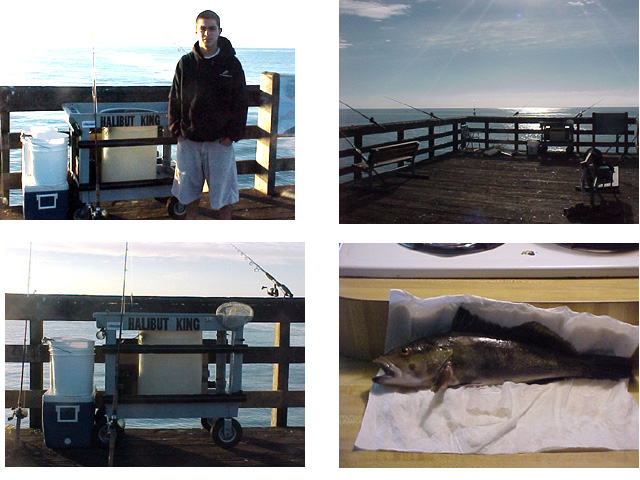
Date: August 13, 2002; To: PFIC Message Board; From: pierhead; Subject: Goleta’s Dolphin Lady…
Dolphins seem to excite our imagination … at least it does for this particular ‘regular’. I first met her early one Saturday morning while I was fishing towards the end of the pier. I heard someone at the end imploring someone else named Flipper to ‘come up out of there.’ I didn’t pay much attention until she started kicking and pounding on the railing. At that I went over and asked if I could help … thinking that maybe someone she knew had climbed down under the pier and was having problems getting back up. She informed me that she could communicate with the Dolphin’s (we have a resident pod that got stranded during one of the El Nino’s) and they always came when she called them. Except for today as Flipper was being ‘naughty’… oooKay … with that I went back to fishing doing my best to ignore her. Finally after 10 minutes or so she seemed satisfied that Flipper had acknowledged her and she left the pier. During the entire encounter I had seen no dolphins whatsoever.
Didn’t think much of it until several weeks later when she reappeared with a reporter in tow and repeated the whole scenario. Afterwards the reporter sidled up to me and quietly asked if I had seen the dolphins that the women insisted had been there. I told her she had to use her imagination as dolphin’s were magical creatures and didn’t appear to just anyone … just to those who believed in them. With that the reporter turned around and marched off the pier. Pierhead
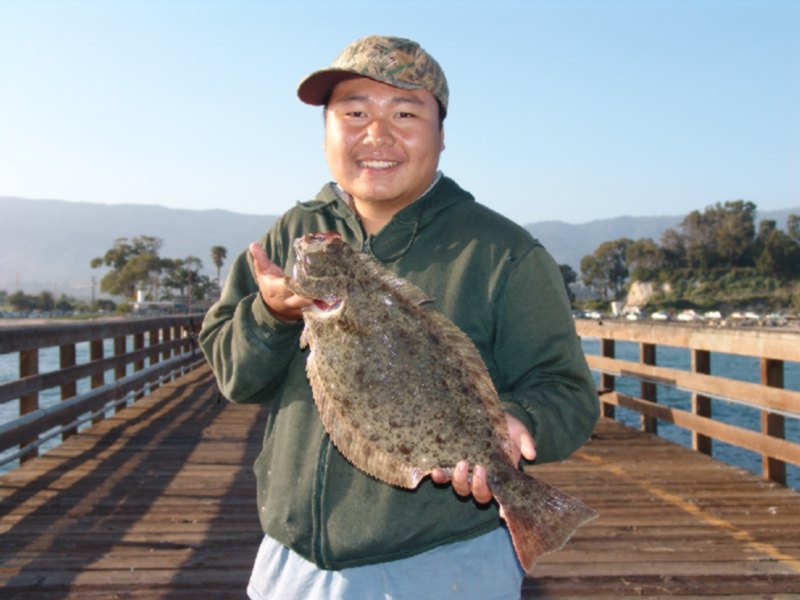
Halibut
Date: April 20, 2003; To: PFIC Message Board; From: pierhead; Subject: New species
Fished just after the low tide this morning. No wind and very calm. Still exploring the reef from the restroom area to the first west side light. Trying to see how this part of the reef—without much kelp—might be different from the heavily ‘forested’ area I usually fish. Met with Shaun (aka Goonerdude) and began working the reef with whole anchovy and some squid strips.
While Shaun threw a new lure I got a pretty good hookup. Took a whole anchovy as well as some line. With Shaun’s help we got it netted and up on deck. Hadn’t seen one like this before … at 20 inches its shape resembled a shovelnose but the coloring was all wrong. It had dark wavy and mottled lines across it like it was in deep shadows. It also had what looked like a thornback’s row of spines on the back. Shaun looked it up in the Petersen Field Guide and discovered it was a banded guitarfish. First one I’ve seen at Goleta and a brand new species for me!
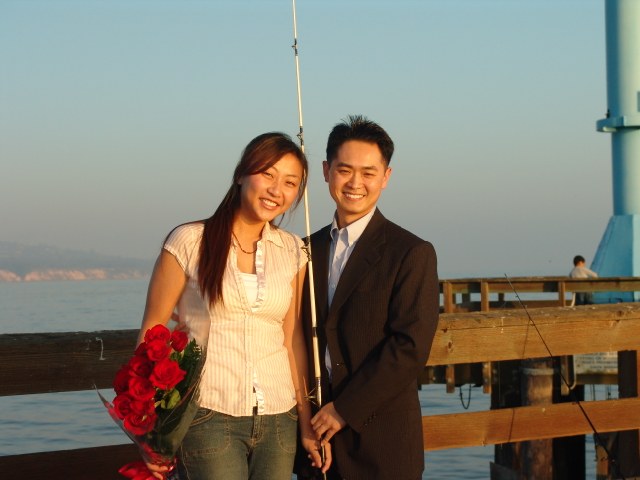
Yes! Nothing like a wedding proposal out on a pier!
Date: April 29, 2003; To: PFIC Message Board; From: pierhead; Subject: New pole and Lingcod
Which two California piers were threatened by closure in 2002 due to the number of pelicans being caught by anglers? That’s the trivia question that Ken posed at the Catalina Derby. Knowing that the prize was a beautiful 7-foot, one piece, hand-built and custom wrapped rod by none other than Gyozadude himself I shouted out the answer—Stearns Wharf and Santa Cruz—completely forgetting that I was supposed to preface it with my board name. But they cut me some slack …
Today I took the rod out to Goleta to formerly inaugurate it. Got there around 7am to fish the incoming tide. Set up on the west side just behind the breakers hoping for halibut but there were no baitfish to be had so I settled for squid and anchovy which were spectacularly unsuccessful. Finally some 6” sardines showed up around 11am and I baited both G-dudes pole and a 10′ Sealine- X with them on slider rigs. While I was temporarily away the Sealine went bendo and a friend rushed to help out.
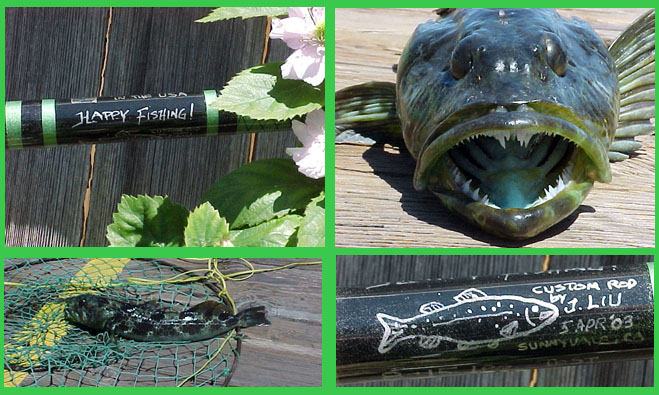
Because he was unfamiliar with the drag system on the Shimano Baitrunner and wasn’t aware that I was using Circle hooks the fish got off just as I got back. But it was a start and I rebaited and tossed out again. Within 5 minutes the Sealine went off again and this time I was able to bring it in … a 20” thornback that had managed to lip the hook but couldn’t swallow the bait because he was stuffed to the gills with sardines … there was even a tail sticking out of his mouth!
Well, my rule of thumb is that when the thornbacks show up I split. Besides the wind was coming up again and I don’t think I have ever caught a fish when it was windy. But just before I packed up I decided to move up the pier to give it one more try. I really wanted to be able to post a catch on the new pole as a way of thanking James for both the pole and the kind thoughts expressed towards me in a post yesterday.
Sabikied up a couple more sardines and cast out—giving his pole the favored position in the kelp reef. Didn’t take long—down went his pole and up came a beautiful 22” green lingcod which went 3 pounds 3 ounces. How appropriate as green is my favorite color and it also matches the wrap on the pole. By the time I had measured, weighed and photographed it the fish was kind of tuckered out. So I placed it back in my net and lowered it over the side. It revived within a couple of minutes and slowly swam away. Mission accomplished!
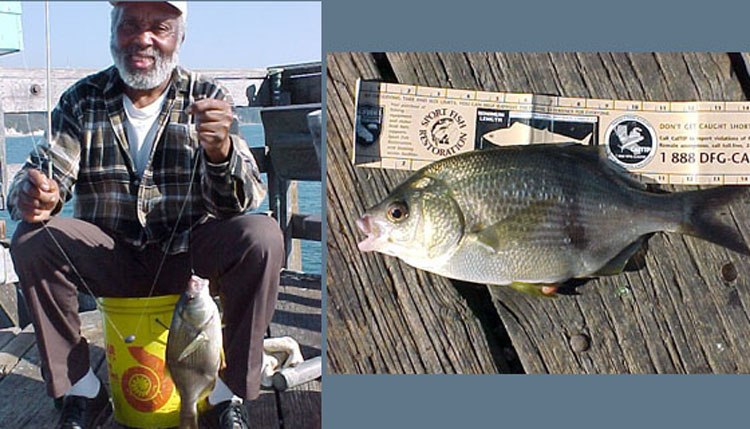
Pileperch
Date: August 31, 2003; To: PFIC Message Board; From: pierhead; Subject: Goleta Pier 8-31-03
Now I don’t normally fish for halibut but today I had a reason—the universe owed one of the regulars big time and I figured I could be the vehicle to make that happen.
Here’s the story: Yesterday Fred varied his regular perchin’ routine and used a whole anchovy instead of cut bait … and wouldn’t you know it he gets hit big time. Like a 30” halibut big time. And no net because he is a percher … But he goes through this routine several times a year so he is kind of used to it.
Walks the fish down to the surfline and floats it high up on the sand on the biggest wave of the set. That gives him some time to run down and pick it up. BUT, Augie says he will get it and makes a beeline for it. Fred, being the patient guy that he is and knowing that Augie sometimes needs to feel useful, nods his assent and watches him approach the fish, bend over and … freeze. Perhaps it was the teeth that were snapping at him. Perhaps it was something else. But whatever … he just can’t make himself pick up the fish.
‘Get it!’, yells Fred from up on deck. No response. ‘Get it!’, yell the bystanders crowding on the beach. No response. ‘Get the fish, Augie!’, yell the kids from the Spec Ed school touring the pier.
But Augie just stands there watching as the fish comes unbuttoned and starts flopping around just above the incoming waves. Time is running out … the waves are getting closer. And Fred is about to lose the biggest halibut he has had in years.
Finally one of the bystanders races over to the fish and steps on its tail … which squirts the fish into the next wave. Nice clean release… but not what Fred had in mind. But, as I said, Fred is understanding and by the end of the day had converted his personal tragedy into a very funny fish story that will stay with the rest of us much longer than even a 30” halibut.
So after hearing that story from Martin (GreenRag) last night I made up my mind that I was going to try to replace the fish that Augie lost. Woke up this morning thinking of Songslinger’s halibut floats at Berkeley Pier and decided that was the way to go.
Now at Goleta bobbers are rarely used so I got a lot of questions this morning. I also got to watch the bobber get sucked under and run with 2 times and then, with some adjustments, finally landed 2 halibut (16 and 21”) before losing the rig (and the only bobber I had with me) to the pilings.
Couldn’t replace Fred’s fish but did find a way to fish for halibut that I really liked … bobbers are fun and very visual when they get sucked under. You can see just how long the fish runs before it stops and swallows the bait. Using circle hooks (and the drag provided by the bobber) it’s just a matter of time before the fish moves off again and hooks itself.I used a 1-oz slider with a 30” leader and a #6 circle hook. Put the bobber about 4′ above the weight and pinned a frozen anchovy through the nose. I used to pass the hook behind the eye and wrap the body several times before pinning the tail but the two I lost this morning were done that way. So I just did the nose thing and the bait had a more natural movement. The first two (wrapped) baits had large semi-circle bites out of the stomach whereas the nose-hooked were taken in completely. The wind was against me so I cast out 25 yards and let the bobber drag the bait back to the pier. All 4 hook-up were within 10 yards of the pier and 25 yards from the surfline.
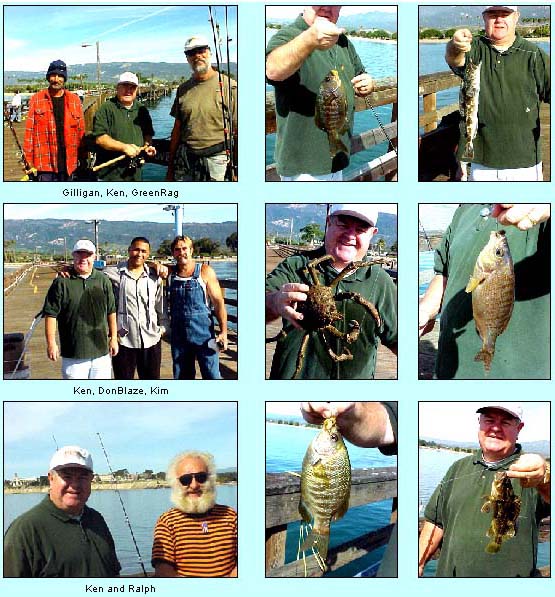
A visit to the pier by myself in 2004 — Collage by Pierhead
Date: July 8, 2005; To: PFIC Message Board; From: dompfa ben; Subject: Goleta Pier & Beach, Awesome Friday 12-3 A.M.
Got a late start leaving Pasadena last night. With reports of algal blooms from Ventura south, we decided to take the long drive to Goleta. It turned out to be one of the best pier-fishing decisions we’ve made this year.
I arrived with my dad and brother Dan around midnight. As we walked out onto the foot of the pier, we noticed the tide was impressively high—and that there were hundreds of shimmering fish dancing across the sand…GRUNION RUN! Dan and I scampered down onto the beach and grabbed about a dozen for bait. Already, I was very pleased with the decision to drive all the way to Goleta.
After setting up near the crane, using hi-lo’s and dropper loop setups ranging from 8#-30# test, we started catching fish as soon as our bait hit the water. Dan immediately put three grass rockfish on the pier with his first three casts. Dad quickly got in on the act, and started making perfect 5-6” Spanish mackerel for bait with a Sabiki. Holding the Sabiki stationary seemed to do the trick, instead of jigging it up and down.
Around 1:00 A.M. we saw an angler at the end of the pier hook up big-time with the long rod. Half an hour later, he was right next to us, after having walked an estimated 80-lb. bat ray (SoCal Gangsta’) down to the crane. He didn’t have a net or a pier gaff, and was going to try to land the fish from the lower gangplank. I assisted by holding his rod, while he fashioned a lasso and tried to work it down around the brute. Alas, the knot parted after several unsuccessful attempts, and the big girl lived to fight another day. The angler was a nice guy named Tyler, and as we said fare-thee-well, we made a verbal agreement to bring landing nets with us from now on.
The fact that we did not have a landing net also became apparent on the next cast, when Dan hooked something huge on a live Spanish mack. A 5-minute fight through the kelp produced the largest swell shark I have ever seen. It was easily 4 feet long, and was probably pushing 25 or 30-lbs. We tried to hand-line it up, but the 30 lb. test snapped like string on a Big Lots kite.
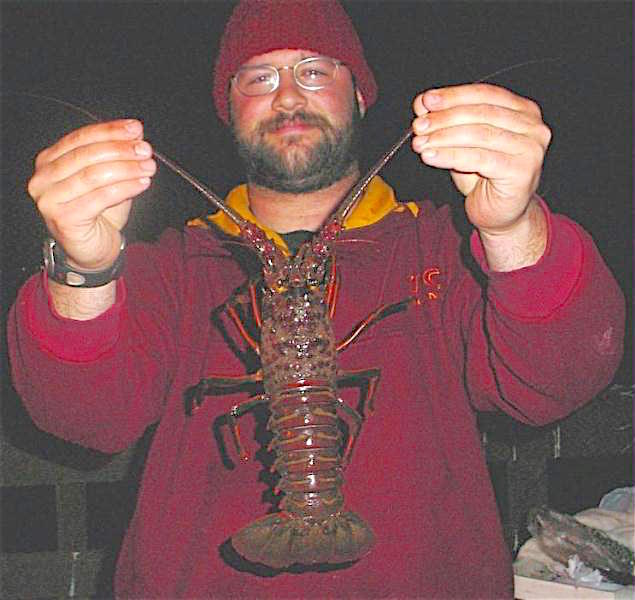
Dompfa Ben and a lobster
Last night also marked our first lobster of 2005—a close-to-legal male hooked in the mouth on squid. Like everything else caught last night (except for the grunion) it was returned to the water unharmed.
After an epic night of pier fishing, our decision to head for home was delayed by Dan’s rod going off (again…), fishing a live Spanish on 25#, egg sinker sliding rig, and a 2/0 Gamakatsu live bait hook.
“Going off” isn’t quite the right expression…BLASTING off might be more appropriate. A huge bat ray had inhaled the bait, and was heading for UCSB. The big ray took Dan from the elbow all the way to the surf line, running all the way. When the big fish got shallow, it really hit the accelerator. With the reel screaming and line peeling down towards the knot, Dan made the decision to glove the spool. The big ray was gone–but as Dan said, better that it just has a pierced lip, than a pierced lip with 200 yards of mono trailing behind it in the surf line. Good call.
Truly, this was one of the most memorable trips I’ve had in a while. Despite the late night, we had a great time with awesome fishing and nice weather. The grunion are forecast to run again tonight. Don’t forget your licenses. I’m still debating if I’m heading back up there tonight to see a repeat performance.
Totals for the night: 12- grunion; 1- 25 lb. swell shark; 10- assorted small rockfish; 1- spiny lobster; 1- white croaker; several incidental crabs; 1-giant bat ray — “all you want” bait- shiner perch, Spanish mackerel, one greenback mackerel, and a few smelt mixed-in. Go get em! DOMPFA Ben
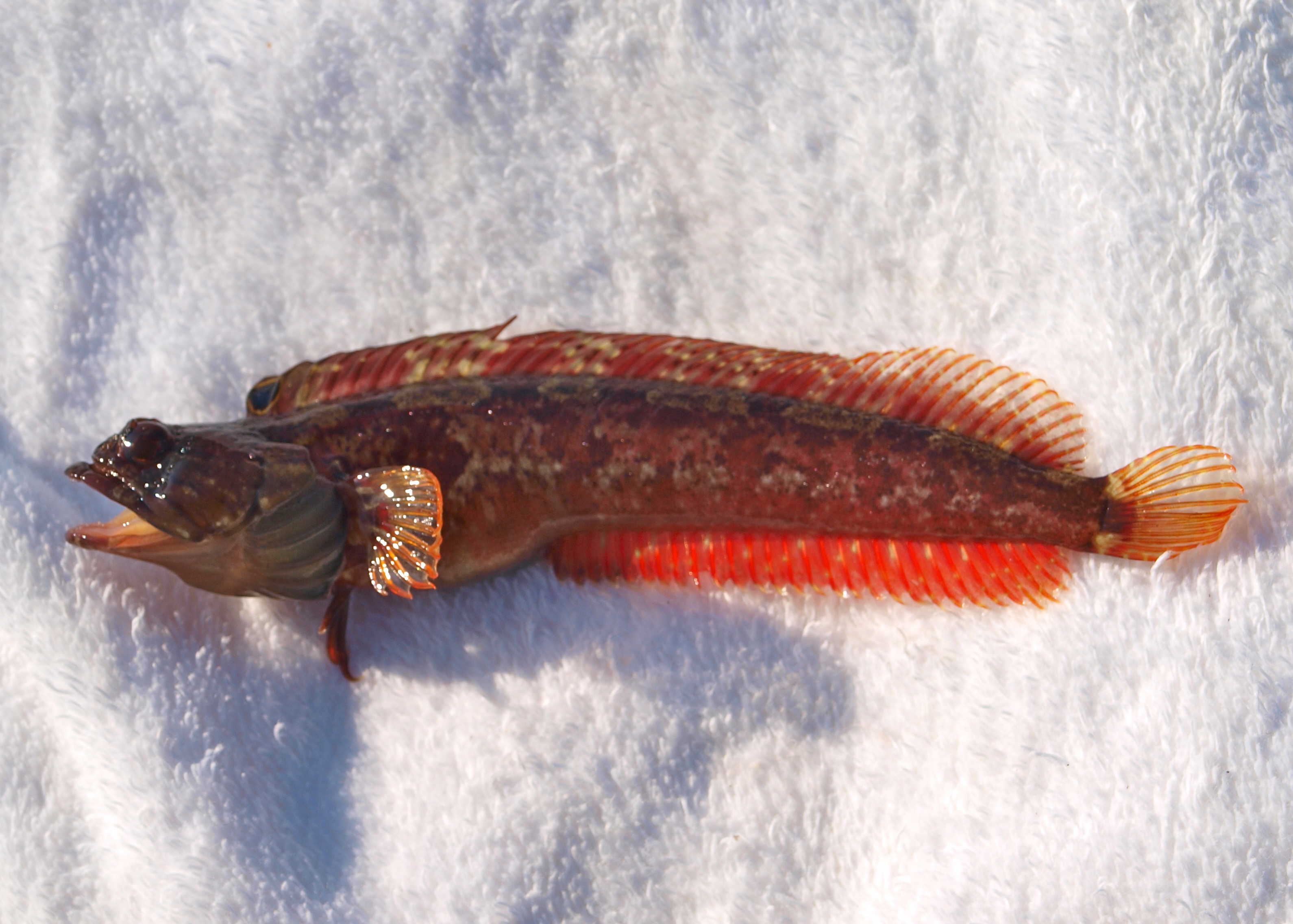
Onespot Fringehead
Date: October 1, 2005; To: PFIC Message Board; From: abbazaba; Subject: Unknown fish tonight at Goleta
Not really a lot of bait in the pier for most of the day until around five when the macks showed up. I was out there with pierhead, big Goleta kid, and seabass seeker. It wasn’t so hot. I caught a few little rockfish, some macks and some little perch. BGK’s dad caught a 30” angel shark…and there were a lot of real baby spider crabs cruising around. Got a keeper red rock crab in my net, and seabass seeker pulled up a crazy looking eel fish thing in his net. It looked like a fishes head and it really didn’t have teeth but it definitely had an eel body; a nice fat parasite crawled out of its gill too…I think pierhead got some decent pics so he might post them.
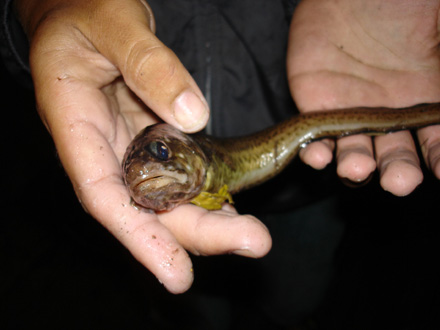
Fish dubbed a “Larval Goa’uld alien symbiot” Uh, O.K.
Date: June 1, 2008; To: PFIC Message Board; From: Ken Jones; Subject: Knuckleheads and Chowderheads at Goleta Pier
I talked to Boyd and he said it was an interesting day at the pier today, especially when massive bait balls of anchovies appeared next to the pier. Within an hour the number of anglers at the pier went from about twenty to over sixty. Aren’t cell phones just grand?
Scenes: (1) A thirty-five-year-old (or so) mother and her teenage daughter decide to jump off the pier near the hoist while making sure they held on to their forty-ounce malt liquor cans. Lifeguards finally got them out. (2) Kayakers are going back and fourth under the pier and through the fishing lines. Unhappy anglers on the pier! (3) Two small private skiffs decide to troll up and down the pier about twenty feet out from the pier. Anglers weren’t happy! (4) Two divers emerge from the depths and climb up the steps by the hoist. They’re carrying a bucket full of 4-6 inch perch that they managed to harpoon. They walk back to the shoreline in their wet suits amidst catcalls from the “rats.” Just another day in Paradise.
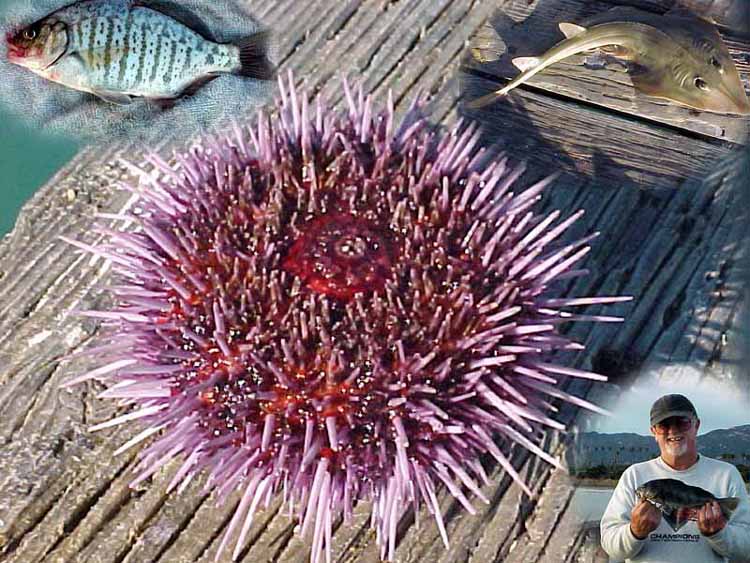
Collage by Pierhead in 2003
Date: September 21, 2008; To: PFIC Message Board; From: Kawtnuffin; Subject: Goleta Pier
A bit late for today, but Goleta has been very slow all summer. I fished the end 1-4 today across the top of the tide and it was better than average, but still a long time between anything. People were getting jacksmelt reliably inshore, and some sardines were hanging around about 1.5 casts out most of the afternoon, with a few loners coming to the 1 lo-ong cast mark. Using cut sardines got me a couple of queenfish, 4 mackerel, a short calico, a HUGE jacksmelt and a walleye, and for a bit of a surprise a 26” WSB (carefully raised and lowered by net, swam off fine). Others at the end got a 3’ guitarfish, a 30-lb bat ray (latter released) on sardines bummed from some guy, a short halibut and a legal calico and a couple of decent perch came up within my sight back down the pier. Mind you, this is about 3-4x more fish catching than has typically happened here since late June.
Windy afternoons and murky water, with a great deal of salad inshore, have been the norm at Goleta this summer, and today was no exception. Sardines and macks have been mostly absent, and gone in a flash when they do pass through. The clear water line usually stays about 2-3 cast lengths off the end, thanks to the wind alignment and the surf breaks at Goleta Point.
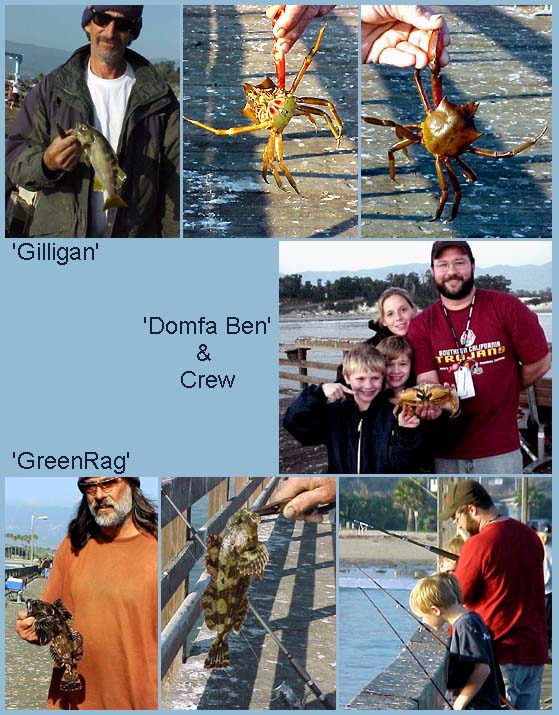
Collage by Pierhead — 2004
Date: February 28, 2009; To: Ken Jones; From: fishboy; Subject: Swell Sharks
Just saw your revised swell shark article. You mentioned that small swell sharks are not able to puff up like the adults. Was just wondering where you found this bit of information. My understanding from those working at the miniature UCSB aquarium/touch-tank is that even with newly hatched swell sharks under a foot long, gulping air is a problem. While I am not sure if they are able to gulp in enough air to create a distended stomach like the adults, it is something they try to avoid, and if one of the small swell sharks does gulp air, they need to burp it. Which leads me to another interesting thing that you may consider adding to your article. They prevent these small swell sharks from gulping air by holding their mouth closed when they are out of water. Because swell sharks are actually gulping air/water, holding their mouth shut prevents them from doing this. I have been using this technique fairly successfully with the swell sharks we catch off of Goleta Pier as well. After we pull a swell shark to the surface, we try to keep it in the water until we can get our crab net ready. As soon as we net the shark and pull it out of the water, we pull it up as fast as we can and grab the mouth and hold it shut. This gives us all the time we need to untangle the lines from the net and remove the shark. Then allow the mouth to open for only as long as we need to remove the hook, and then again lower it as fast as we can in the net to get it back under water. Before learning this trick, we had numerous incidents where released swell sharks had gulped so much air that they were unable to submerge themselves and were left floating belly up, but since learning this technique almost 100% of the swell sharks we release have been able to swim down to the bottom. Roy
Hi Roy, In Probably More Than You Want To Know About The Fishes Of The Pacific Coast, Milton Love says “Curiously, small swell sharks, which you would think would benefit from the ability, don’t seem to be able to puff up.” That’s my source on the info but I find your note of great interest. Perhaps we need to revise it a little?
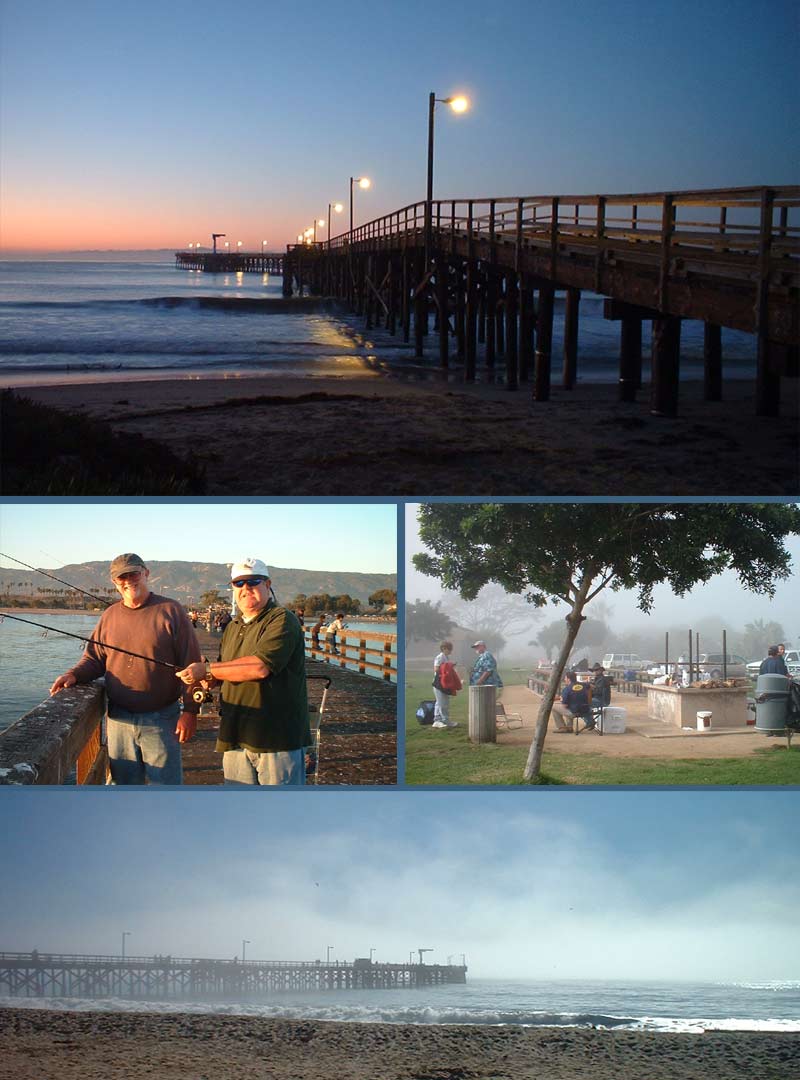
A collage by Pierhead — 2004 — Boyd, myself and the “Get Together”
Date: December 3, 2009; To: PFIC Message Board; From: pierhead; Subject: Goleta Pier sharking … 12-3-09
Finishing my rounds as a resident Park Host this morning I came across a group of night shark anglers with an unusual (for Goleta) catch, a seven-foot, nine-inch sevengill shark. I met Brandon Nguyen (from Malibu) who said he caught the shark around midnight using a large chunk of mackerel. He and his two friends were unable to lift it out of the water by themselves and waited until 6pm when Greenrag and another local showed up to help.
I called the other Park Hosts who came out with the Park utility vehicle and the shark was carted to the Angler Center for pictures and then to one of the cleaning stations. Brandon said he had a freezer full of shark meat and, after taking the head for a scientist friend, left the rest for the regulars to divide up. Roy Qi did an excellent job of filleting and the meat was distributed.
Brandon and his group heard about Goleta from friends and pierfishing.com and have been here for the past several weekends to enjoy what has been a spectacular run of big sharks. Several weeks ago there were four threshers, two large soupfins, and a six-foot and seven foot sevengill caught in just one weekend!
Tackle included a Avet SX 6/4 M.C. reel loaded with 65# braid terminating in 5 foot steel wire leader and a 10/0 hook. The pole was a 7.5 foot Classic Pro Deckhand Special.
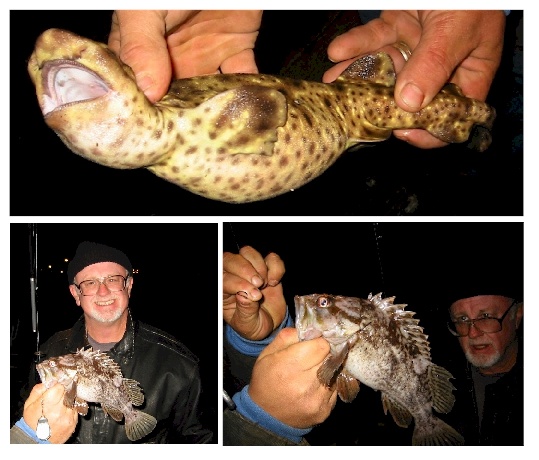
Collage by Pierhead — 2002 — Pierhead, swell shark and brown rockfish
Posted by q3fishboy
A few people commented on the seemingly wasteful nature of Brandon leaving his catch behind. I just wanted to clarify a couple of things. Brandon does not actually have a freezer full of shark. It was Gerel (spelling?) who was one of the Brandon’s friends that was fishing with him who said he had a freezer full of shark meat and turned down the offer to take some, though he ended up taking some anyway. Brandon ended up running away without taking anything because as a result of waiting for help to pull the shark up to the pier he was running late for class and other commitments back at home. So, unfortunately, he did not get to stick around while I filleted the fish and took some of it home
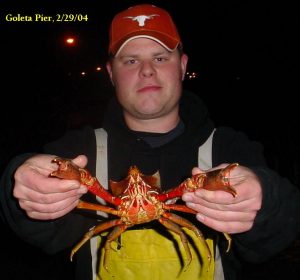
Dompfa Dan and a kelp crab
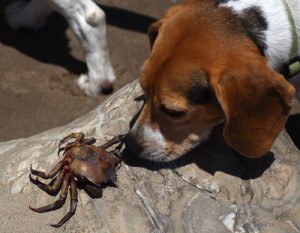
Potpourri — Perhaps more than you may want to know about the Goleta Pier
<*}}}}}}}}}>< — Did You Know? There is a prize-winning flower named after the pier. It’s an orchid Lc. Orange Embers ‘Goleta Pier’ developed by the Suwada Orchid Nursery.

<*}}}}}}}}}>< — Did You Know? The beach upon which the pier sits is partly man-made resulting from operations that covered the existing sand spit with additional sand in 1945. Unfortunately there has needed to be constant and costly efforts to keep the beach from eroding away. Since the mid 1980s the beach has been eroding an average of 20 feet-per-year. Fear that the seaside park would eventually fail to exist has resulted in several different plans and millions of dollars have been dedicated toward preservation. Latest plans include widening the inner portion of the pier and adding several hundred additional pilings to change water flow and block the flow of sand away from the beach.
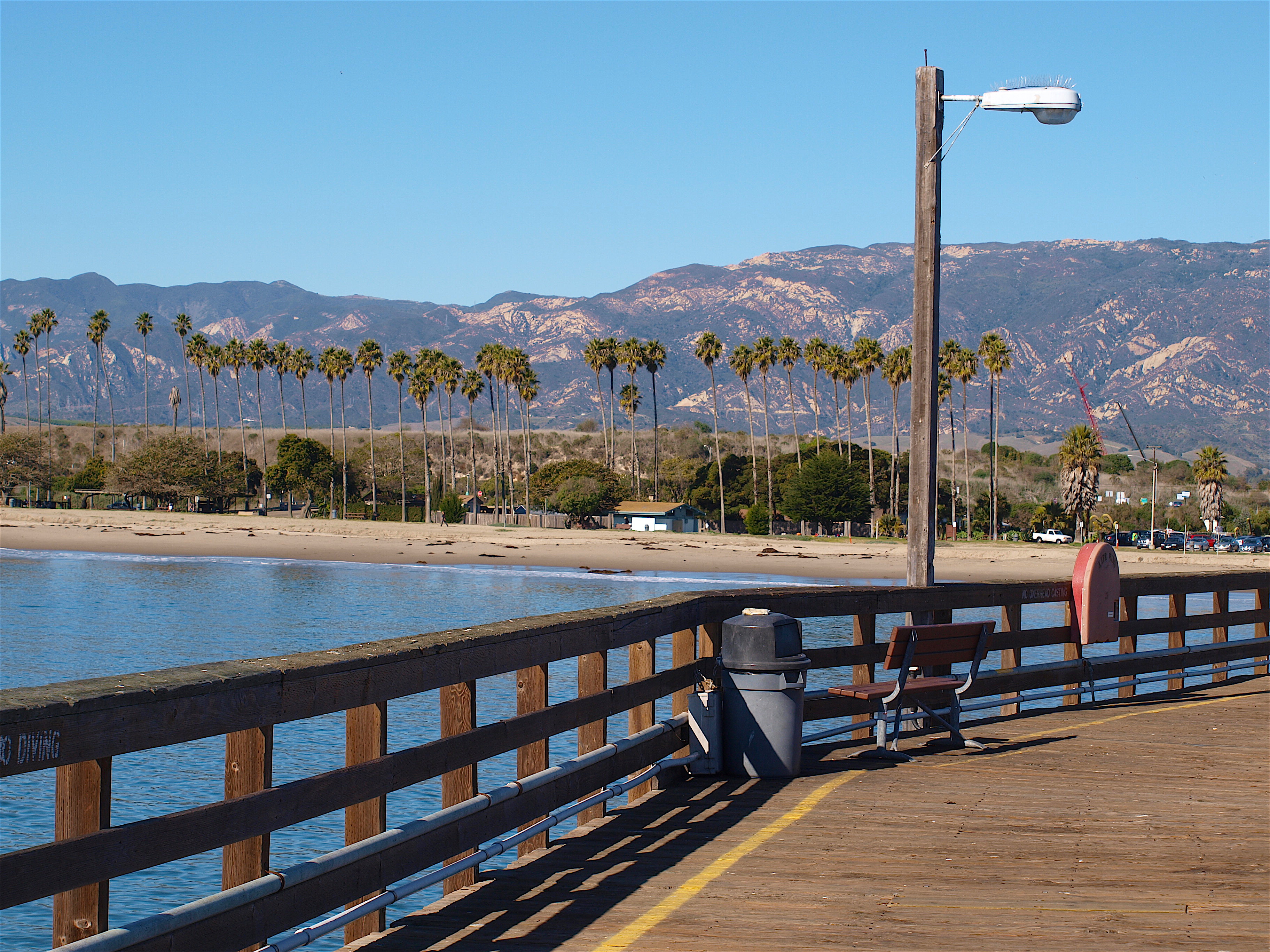
<*}}}}}}}}}>< — Did You Know? The Goleta Slough is a tidal estuary, the largest between Point Mugu and Morro Bay. It drains the Goleta Valley and its entire watershed. The slough receives water from local creeks and those that drain from the southern face of the Santa Ynez Mountains. Wetlands that today cover about 430 acres once covered 1,150 acres. Construction of the Marine Corps Air Station, Santa Barbara, along with the subsequent construction and expansion of the Santa Barbara Airport, has covered up most of those wetlands. 279 different bird species have been recorded from the Goleta Slough.
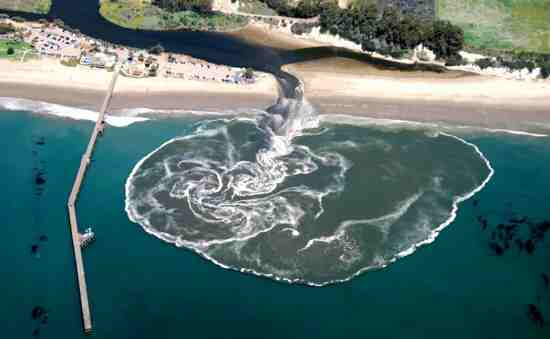
The opening of the slough in April 2008
<*}}}}}}}}}>< — Did You Know? During World War II a crane was installed on the pier for training Marine airmen. An old torpedo plane fuselage was suspended from the crane. Trainees in full battle gear would enter the fuselage as though entering a plane and then the fuselage would be dropped 15 feet into the water. The crews had 60 seconds to orderly abandon ship and properly inflate a life raft. Sometimes the trainees were also dropped from the crane in parachutes. Records do not record how many men failed to perform these exercise in a timely manner or their fate if they failed.
<*}}}}}}}}}>< — Did You Know? One day I was fishing with Boyd near the Angler Center when a nearby angler hooked into a decent-sized bat ray. He played him up to the surface at which time Boyd dropped down a hoop net that we used to bring the heavy fish up to the pier.
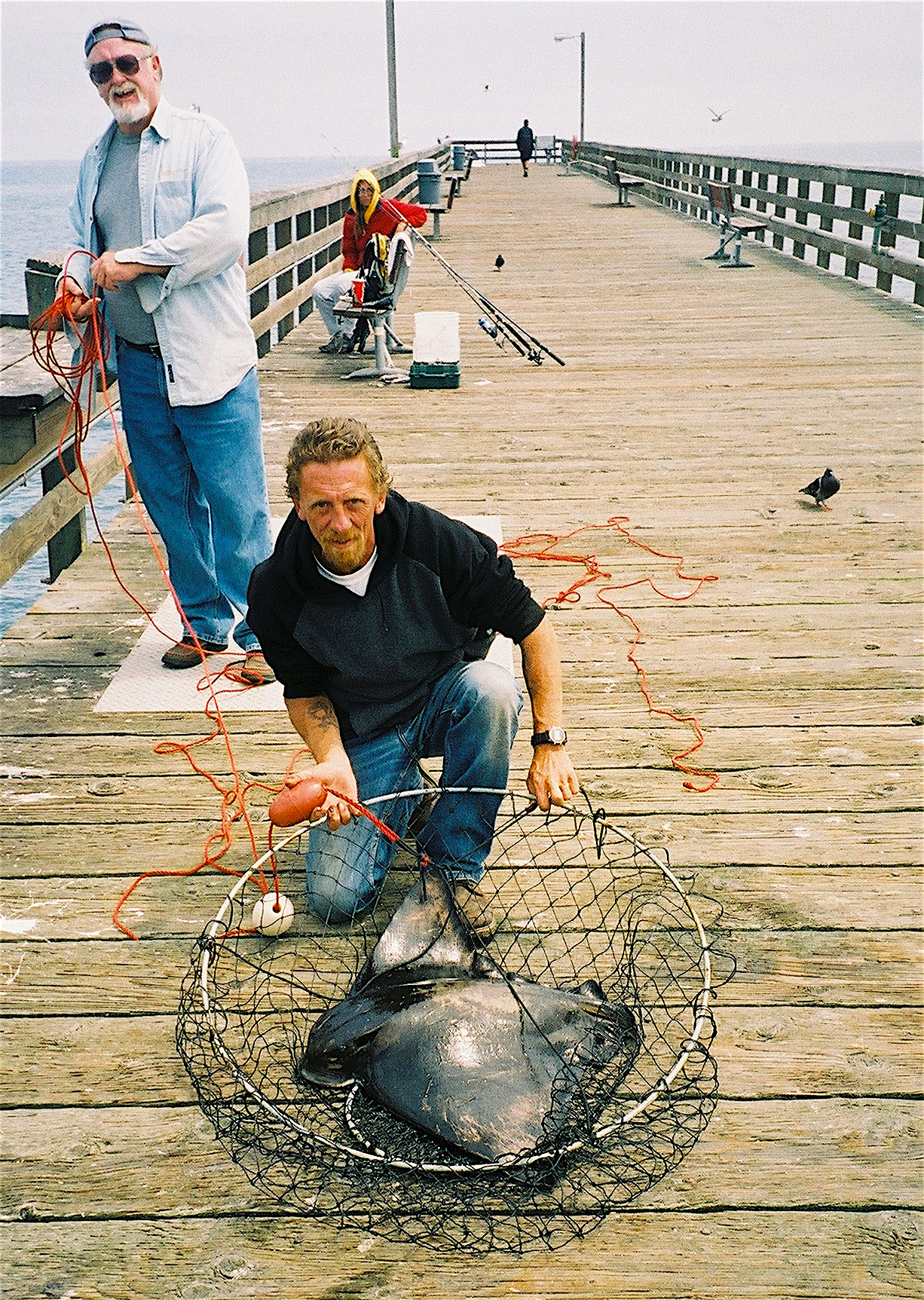
An oleaginous bat ray
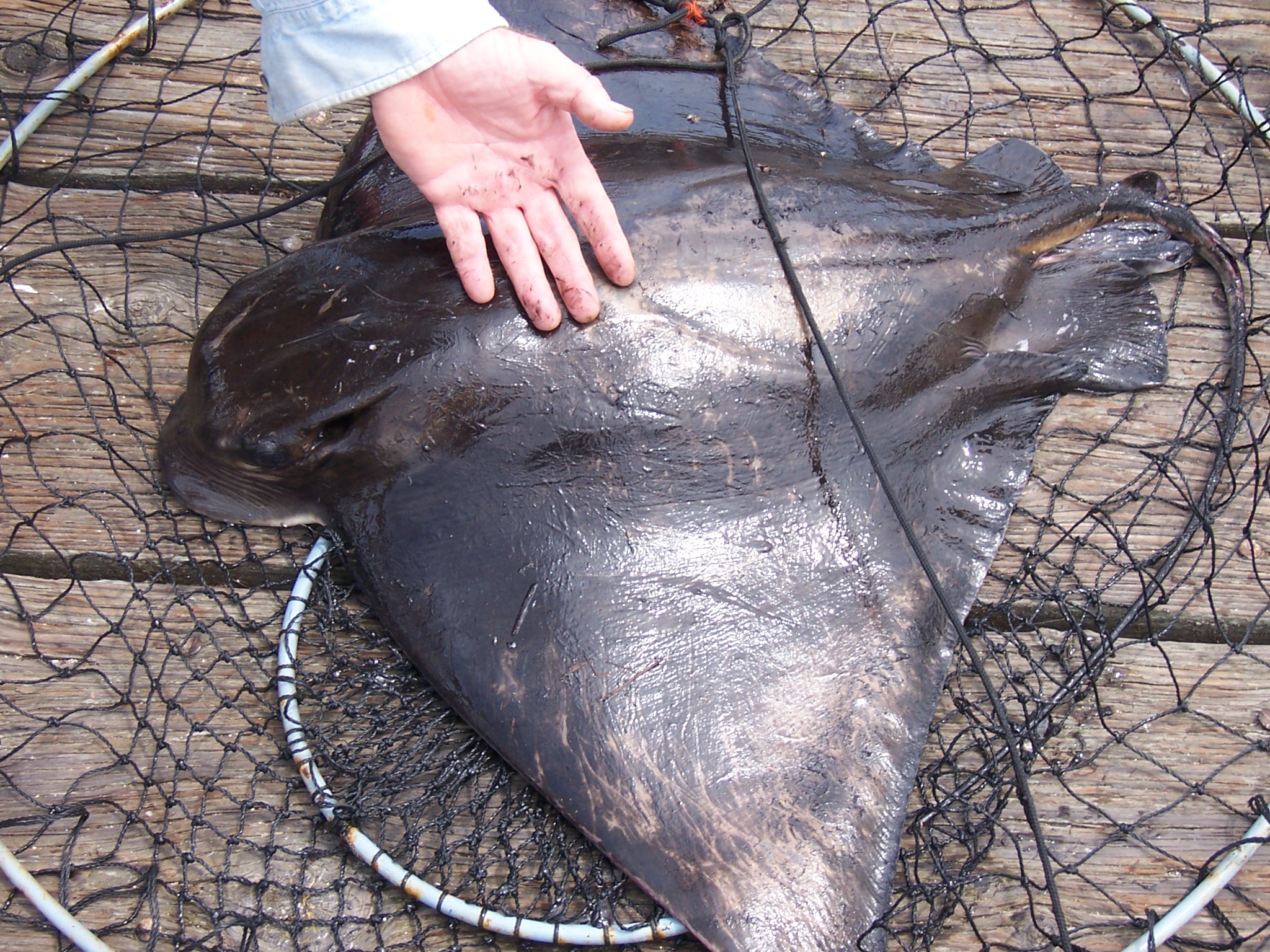
As we looked at the ray, we noticed it had an oily look to it and indeed it was somewhat slick and seemingly coated with what appeared to be light oil. Boyd mentioned how oil actually seeps out of the bottom of the bay near the pier and sometimes there will be a natural sheen of oil on top of the water (no, it’s not an oil spill). In checking, I found the following:
Offshore Santa Barbara has the second largest marine oil seeps in the world.
The largest natural oil and gas seeps in the Western Hemisphere lie in the Santa Barbara Channel. According to the California State Lands Commission, they comprise more than 1,200 of the over 2,000 active submarine seeps along the California coast. Half of these occur within 3 miles of an area called the Coal Oil Point located just west of Santa Barbara near the University of California, Santa Barbara (UCSB) campus. [The Goleta Pier is situated just down the hill from the campus.]
It is estimated that oil seepage for a single 6-mile stretch, including Coal Oil Point, averages 10,000 gallons of oil each day (240 barrels). Every 12 months about 86,000 barrels of oil seep into the ocean—the equivalent of the quantity of oil spilled in the 1969 Santa Barbara oil spill. Since 1970, the quantity of oil that naturally seeps into the Santa Barbara Channel equals ~ 31 “1969” Santa Barbara oil spills. http://www.soscalifornia.org/natural-oil-seepage-facts/
<*}}}}}}}}}>< — It’s rare to gain access to truly detailed fishing information (including personal logs) about a pier but here, due to an amazing person, it’s available. Boyd Grant, better known as pierhead to those at PFIC, adopted the Goleta Pier as his own in the late 1990s and became its main protector as well as its most vocal advocate.
Eventually, largely through his vision and hard work, United Pier and Shore Anglers of California (UPSAC) was able to develop the UPSAC Angling Center at the Goleta Pier and Boyd became its “pier host” although director was perhaps a more fitting term (see below).
His daily efforts together with a regular groups of “pier regulars” who helped keep an eye on the pier made Goleta one of the best kept and safest piers in California for the angling public.
As a bonus, Boyd also began a couple of personal web sites that offer an unparalleled look at the day-to-day life on an individual pier.
http://pierhead.freeservers.com/PierLog/Pier%20Log%20-%20March%202007.html
http://www.pierhead.freeservers.com/PierLog/Archives.html
Below is just one year’s information from his log and though every year is different it provides an intriguing look at the life of Goleta Pier.
June 2002 — Total Fish this month: 106 — Number of species: 16
Summary: Rockfish continue to be the predominant catch in the kelpline from the 3rd quarter of pier using either anchovy or squid. A few White Seabass ranging from 18-30” caught in surfline early in month. Other unusual catches included a 12# Black Sea Bass caught on 6/10 at the surfline and a 48” Blue shark caught 6/19 off the end. Did receive an unconfirmed report of two Striped Bass caught 6/2 off the end. Halibut to 30” are beginning to appear but not in the numbers like last year. Fish—staghorn sculpin, Pacific mackerel, white croaker, barred surfperch, blue rockfish, brown rockfish, kelp rockfish, bat ray, thornback ray, shovelnose guitarfish, brown smoothhound, barred sand bass, kelp bass, lingcod, anchovy, shinerperch, jacksmelt.
July 2002 — Total Fish this month: 72 —Number of species 23
Summary: Rockfish remain the predominant catch in the kelpline on the west side of the pier. Increased species count by fishing pilings as well as kelpline and channel between pier and kelp. Beginning to see some ‘El Nino’ species—Senorita fish and Rock Wrasse. Halibut are also beginning to be caught regularly as the water warms above 64 degrees. The Corbina are still very active inshore along the surfline as well as a few White Seabass in the early mornings. Several large Bat Rays caught towards end of month—one was estimated to be over 100 pounds. Baitfish are still somewhat scarce but Mackerel are showing up with some frequency. Fish—Pacific mackerel, black perch, silver surfperch, black rockfish, blue rockfish, brown rockfish, black & yellow rockfish, grass rockfish, kelp rockfish, olive rockfish, thornback ray, shovelnose guitarfish, swell shark, barred sand bass, kelp bass, California halibut, California scorpionfish, senorita, mackerel jack, queenfish, jacksmelt, shinerperch, white croaker
August 2002 — Total Fish this Month: 49 — Number of Species: 18
Summary: Major change this month was a drop in water temperatures during the 3rd week from 65 to 57 degrees. Too soon to tell if it has affected the halibut catch although it doesn’t appear to have made much of a difference so far. Rockfish catch rates were down in the first 2 weeks but seemed to have bounced back—perhaps due to the lower water temperatures? Grey Smoothounds and swell sharks are still being caught as well as the occasional WSB. The corbina are no longer appearing in great numbers (as of the third week) nor are they as easy to catch but baby squid are showing up at nights under the lights. There have been reports of the occasional giant Humboldt squid appearing on the beaches. Fish—staghorn sculpin, white croaker, Pacific mackerel, mackerel jack, silver surfperch, blue rockfish, brown rockfish, black & yellow rockfish, grass rockfish, kelp rockfish, thornback ray, brown smoothhound, swell shark, barred sand bass, kelp bass, California scorpionfish, giant kelpfish, shinerperch
September 2002 — Total Fish this Month: 74 — Number of Species: 13
Summary: 9/7/02 Confirmed 16 pound Striped Bass caught on whole frozen anchovy tossed under the pier. 9/14/02 Large Barred Surfperch (12-16”) being caught on sidewinder crabs near foot of pier. 32” Halibut caught on live smelt midpier eastside. 9/22/02 Several large (25”) Corbina snagged in surf. 9/26/02 1st sand bass in a while. Fish— Pacific mackerel, white croaker, queenfish, Jack mackerel, blue rockfish, brown rockfish, black & yellow rockfish, grass rockfish, kelp rockfish, yellowtail rockfish, thornback ray, gray smoothhound, kelp bass
October 2002 —Total Fish this Month: 79 — Number of Species: 10
Summary: 10/1/02 Major red tide conditions—low oxygen content, poor fish bite. Great bioluminescence. 10/13/02 Red tide has disappeared. Water quality downgraded to C on 10/7/02. 10/14/02 Lots of baitfish— sardines, smelt and anchovy. Good run of mackerel. Water upgraded to B. 10/21/02 Water downgraded to C again. Fish—Pacific mackerel, white croaker, black rockfish, blue rockfish, brown rockfish, grass rockfish, kelp rockfish, yellowtail rockfish, thornback ray, brown smoothhound, gray smoothhound, kelp bass, lizardfish, Pacific sardine
November 2002 — Total Fish this Month: 54 — Number of Species: 13
Summary: 11/6/02 Some baitfish (jacksmelt and anchovy). Water upgraded to A. Heavy rains began 11/7 and ended 11/9. Mud from run-off appeared 11/11 and gone by 11-14-02. Report of a 20” Lingcod caught in kelp reef. 11/23/02. Many short halibut and a few 25-30” caught in surfline. Recent beach sculpting to create a winter berm has deepened the inshore slope causing steeper waves and more water movement. 11/24/02 Red tide again. 11/30/02 Excellent rockfish bite between 5-9pm … sizes are increasing from last months average of 8” and Grass and Kelp rockfish are replacing the summer’s Brown rockfish. Fish—staghorn sculpin, Pacific mackerel, white croaker, brown rockfish, black & yellow rockfish, grass rockfish, kelp rockfish, thornback ray, barred sand bass, kelp bass, California scorpionfish, jacksmelt
December 2002 — Total Fish this Month: 49 — Number of Species: 7
Summary: Under the new DFG regulations effective 1/1/03 rockfishing is closed until 6-30-03. I have had a great year exploring the kelp reef structure and accumulating lots of good data on the rockfish population but now it is time to switch gears—my new emphasis for first half of this coming year will be on the piling structure and associated species like pile and buttermouth perch. I will also explore the wonderful world of Corbina fishing which was outstanding this past year at Goleta. Hopefully I will get a few Sandbass, Calico Bass and Halibut as well as I switch to fishing with live baits jigged up on a Sabiki rig. Best wishes and good fishing to all in the New Year as we adapt to the new restrictions on our sport. Fish— brown rockfish, grass rockfish, kelp rockfish, bat ray, thornback ray, cabezon, white croaker, shinerperch.
January 2003 — Total Fish this Month: 48 —Number of Species: 12
Summary: 1-04-03 Lots of baitfish—small jacksmelt. Large pile perch still being caught on lugworms and small black rock crabs. 1/12/03 Baitfish thinning out. 1/13/03 Baitfish gone. 1/31/03 Baitfish beginning to reappear. Still catching large pile perch and Black perch (Buttermouth) but not as large and not as many as earlier in the month. Very few halibut now but there are still a few corbina at night. Fish—barred surfperch, black perch, walleye surfperch, brown rockfish, grass rockfish, kelp rockfish, barred sand bass, shovelnose guitarfish, Pacific sardine, jacksmelt, white croaker, shinerperch.
February 2003 — Total Fish this Month: 20 — Number of Species: 11
Summary: 2-1-03 Few baitfish in water. One legal halibut caught off end on mussels (25”, 5#). DFG ‘walked’ the pier today in response to recent complaints regarding multiple-pole violations—remember, only 2 lines allowed per person on public piers. 2-22-03: DFG walked pier again today. No baitfish in water. Several whales in bay—reports of a 50’ whale cruising the kelp reef last week. 2-27-03 Large Barred surfperch beginning spring run—sizes up to 16” and most bearing young—please return fry to water if keeping catch. Still no baitfish. Fish—staghorn sculpin, barred surfperch, walleye surfperch, brown rockfish, grass rockfish, kelp rockfish, thornback ray, shovelnose guitarfish, barred sand bass, Pacific sanddab, jacksmelt
March 2003 — Total Fish this Month: 61 — Number of Species: 17
Summary: 3-3-03 Fishing very slow—primarily perch. Some small baitfish beginning to reappear. 1st grunion run (3/4- 3/7/03) did not materialize. 3-10-03 Baitfish back in number—halibut beginning to return …28” caught this weekend midpier on live bait. 3/15/03 Goleta Pier (SB Airport) got 4.74 inches of rain between 1am and 10 am today—most rain of any March storm since 1941. 3-25-03 Rockfish levels returning to Summer/Fall rates -primarily during sunset hours. Water temperatures have dropped from 57 degrees to 52 degrees, which is unprecedented … trying to determine if reports are accurate. More halibut being reported caught west side mid-pier. 3/28/03 Top smelt and night smelt in some numbers. Several more reports of a large (4-5’) Leopard shark—no one has managed to bring it in so far. 3/30/03—water temps still at 52 degrees. Caught a 19” Lingcod and a 16” Monkeyface Prickleback … also saw a 17” Cabezon caught. Fish—black perch, walleye surfperch, brown rockfish, grass rockfish, kelp rockfish, thornback ray, shovelnose guitarfish, barred sand bass, kelp bass, lingcod, onespot fringehead, speckled midshipman, white croaker, mackerel jack
April 2003 — Total Fish this Month: 23 — Number of Species: 6
Summary: 4/4/03 Water still extremely cold (52 degrees). No baitfish in water. Very windy past week. 4/7/03 No wind and water temps up to 55 degrees. 4/29/03 Water temps at 54 degrees for past two weeks due to wind? Schools of sardines and small jacksmelt appearing regularly. Caught a 22” Lingcod … 3rd this year and second this month. Also caught a very rare Banded Guitarfish—possibly the northern-most catch of this species, as it is not usually found above San Diego. Fish—brown rockfish, grass rockfish, kelp rockfish, thornback ray, banded guitarfish, lingcod
May 2003 — Total Fish this Month: 22 — Number of Species: 7
Summary: 5/3/03 Water muddy from recent rain … some baitfish (Jacksmelt) and small perch. 5/7/03 Water temp is the lowest I’ve seen—measured 50 degrees at the pier. Smoothhound sharks beginning to appear—saw the largest one I’ve ever seen—40+” caught at foot of pier. 5/26/03 Pier closed weekdays for next several weeks for piling repairs. Water temps are back up to 54-56 degrees and many halibut are beginning to be caught. Lots of baitfish—primarily small jacksmelt and sardines. Still a good run of large (14-16”) Barred surfperch. Fish— brown rockfish, grass rockfish, kelp rockfish, olive rockfish, thornback ray, and lingcod
<*}}}}}}}}}>< — Fish surveys conducted by the California Department of Fish and Game between 2004-2009 were much less comprehensive than those of Boyd Grant but do give a second view into the species (25) at the pier (listed numerically) — shinerperch, Pacific sardine (all in one year), walleye surfperch, jacksmelt, sharpnose seaperch, black perch, rainbow seaperch, barred surfperch, Pacific mackerel, rubberlip seaperch, white seaperch, pileperch, California corbina, Pacific bonito, jack mackerel, senorita, calico surfperch, staghorn sculpin, grass rockfish, shovelnose guitarfish, white croaker, kelp bass, brown rockfish, giant kelpfish and bat ray. As with many of the F&G surveys taken at piers, they do not seem to show very accurate figures for several species. Included here would be: (1) the lack of California halibut, a regularly caught species at the pier; (2) the lack of several sharks and rays common to the pier (but most commonly seen at night when these surveys do not seem to take place; (3) the reported 23 sharpnose seaperch, a number that seems questionable given their normal range and the fact that none to my knowledge had ever been seen by Pierhead and his regulars.
<*}}}}}}}}}>< — One of my pleasures is seeing how many different species of fish I can catch each trip I make to a pier. Since few visits are over three hours in length the number is somewhat restricted with my highest number being twelve different species during a visit to the Cabrillo Mole in Avalon.
However, I have had two trips to Goleta where I took ten different species. The first took place on my birthday, June 6, 2006; the species were kelp bass, brown rockfish, kelp perch, pileperch, barred surfperch, walleye surfperch, shinerperch, senorita, speckled sanddab, and padded sculpin.
The second trip was the same year but on October 11 when I caught brown rockfish, gopher rockfish, kelp bass, jack mackerel, shinerperch, white seaperch, walleye surfperch, pileperch, rainbow seaperch, and staghorn sculpin.
Several trips have yielded nine species and many trips have yielded eight. A favorite visit took place in March of 2004, a visit that yielded only nine species of fish but included a large spider crab. The mix: lingcod, brown rockfish, kelp rockfish, blackperch, rainbow seaperch, shinerperch, speckled sanddab, Pacific sardine, bonehead sculpin and the aforementioned spider crab.
However, every trip is different and even less species can be rewarding. A visit toward the end of November ’09 saw eight species—kelp bass, sand bass, giant kelpfish, bocaccio, walleye surfperch, shinerperch, Pacific sardine and topsmelt.
Of interest were the calico bass (kelp bass) that I caught fishing just past the Angler Center. Fishing straight down between the kelp and pilings, I managed ten calicos on a combination of ghost shrimp and cut (fresh) sardines. The bass fought well but every one was under the legal 12-inch size (with most measuring about a half inch short). Fun fish, but none destined to join the large sargo and legal calico that I had caught the night before at the Paradise Cove Pier.
<*}}}}}}}}}>< — California Fish Bulletin #96 from 1953 states: “There are no fish handling facilities at the town but this area, in the past, was a center of lobster fishing. It is said to be the first locality where lobster traps were operated from skiffs but this rumor is unconfirmed. In our catch records the landings have been credited to Santa Barbara excepting 600 pounds for the two years 1939 and 1940. The waterfront is now reserved as Goleta Beach County Park with a public fishing pier equipped with hoists for skiffs. Poles and skiffs are for rent.”
<*}}}}}}}}}>< — Although not caught at the pier, one of the most interesting fish to be seen in California waters was one that washed up on the beach at the UCSB Coal Oil Point Reserve, the beach that sits just east of the University and a short 15 minute jaunt from the pier. The fish was discovered on the beach in February 2019 and initially assumed to be a common ocean sunfish, Mola mola, a fish that can reach over 2,000 pounds in size. However, when Thomas Turner, a biologist from the university, decided to show the fish to his son, the plot thickened. Turner took pictures and then uploaded them to a website called iNaturalist. Soon after, he was contacted by fish experts in Australia who had seen the pictures. They thought it might be a different species. Local scientists took more pictures, cut tissue samples to examine, and waited for the analysis. The 7-foot-long fish turned out to be a hoodwinker sunfish, Mola tecta, and it was only the second of its species ever to be seen outside the Southern Hemisphere (one washed ashore in the Netherlands in 1889). What it was doing in local waters was simply a guess although many uncommon and even rare species have been seen in California during and after recent El Niño, warm-water years.
<*}}}}}}}}}>< — In 2006 United Pier and Shore Anglers of California (UPSAC) received a grant from NOAA to build and place “Fishing Line Recycle Bins” on 40 piers. The first pier to receive bins was Goleta and it was an interesting—and fruitful—endeavor. Most interesting were the use of the bins as a recycle spot of sorts for angers who needed to make leaders. Some angler would places fishing line in a bin; another angler would come along and cut off enough line to make a leader, etc. As for the line in the bins that wasn’t recycled right out on the pier? It was saved and sent back to Berkley Fishing Line Company for further recycling. And, most important, the bins led to a decrease in the number of birds being entangled in line! Most but not all since there are always a few people simply too lazy to walk over to the bins and discard their line. Unfortunately age and the elements took their toll on the original bins but (the good news) new, slightly different line bins are still on the pier.
Date: March 18, 2007; To: PFIC Message Board; From: pierhead; Subject: Goleta Pier rescue 3-18-07
Yesterday a local church group held their 2nd annual kid’s fishing derby at the pier. After helping them get set up I took a walk out to the end of the pier. Just as I got there I heard a commotion and noticed a gull flying away from the pier trailing a length of fishing line. The gull settled in the water about 100 yards from the pier and was unable to get airborn again since the loose end of the line had snagged in some floating kelp.
This morning, unbelievably, I found the bird free and up on the railing still trailing the line. I asked M’, one of the regulars, to give me a hand in capturing it. After I took a picture the bird flew up onto one of the light poles with the line dangling down. You can see a small section of it across the bird’s back in the above picture.
‘M’ climbed up on the railing and was able to reach the line and retrieve the bird. While I held it he clipped the line next to the beak and the bird was released. I’ve been told the hook will rust out in a couple of weeks. This is the third bird we have rescued from fishing line in as many weeks.
<*}}}}}}}}}>< — For years one of UPSAC’s goals was to obtain a model pier, both to teach the story and importance of piers as well as to serve as a platform to teach the ways of ethical angling. In 2007, United Pier and Shore Anglers of California (UPSAC), in partnership with Santa Barbara County Parks Department, opened the Goleta Pier Angler Center at a mid-pier location on the pier.
Staffed by ‘Pier Host’ Boyd Grant (pierhead), the center provided fishing and maritime information for visitors to the pier, taught kids how to fish, and encouraged respect for birds and other wildlife. The center received accolades from the public as well as a certificate from the Santa Barbara Board of Supervisors. It was hoped that the center would serve as an example to be copied on other piers.
Amazingly just a few years later changes to the county park’s leadership team brought with it a perceived need to change and although protests were mounted, the change would lead to a closing of the angler center. To this day most people still wonder how the county could have made such a mistake.
The following was written in 2012 in honor of the Angler Center and of Boyd Grant who went far beyond the call of duty in making Goleta Pier a better place for all.
The End of a Dream? Boyd and the Goleta Pier Angler Center
http://kenjonesfishing.com/2012/03/end-of-a-dream-boyd-and-the-goleta-pier-angler-center/
Sometimes things just don’t make sense. That was the reaction when word filtered out in September of 2011 that Boyd Grant, the venerable, Yoda-like “Pier Master” at the Goleta Pier had been asked to vacate his parking space at the County Park. The first reaction was an incredulous WHY? Why would the County do this? The second question asked was if his departure, from what in essence was his home, would be permanent and if it meant the end of the Angler Center?
A better question was if this was the end of a dream, a dream that had been over a decade in the making. In 1997 pierfishing.com came into existence. A few months later Boyd posted his first report, a recap of fishing at the Goleta and Gaviota piers. As communication began, a fellowship developed, and an uncommon interest in the Goleta Pier emerged.
Boyd, a gentle man, interested in the social welfare of his community, saw the pier and park as a perfect place to test a theory. Could a person, through individual example (and an amazing amount of hard work) make a real difference?
Could he impact the behavior of those visiting the pier and park, behavior that in the mid-2000s included a large contingent of homeless alcoholics and druggies who called the park their home and could be abusive and scary to the casual visitor.
Could he impact the fishermen on the pier? Could he bring his ethical views of angling and his “leave it cleaner upon departure than arrival” philosophy as far as pier cleanliness?
Lastly, could he impact the way the County treated the park and pier? Could he convince the County workers that they should take pride in their duties and get a buy in on the importance of the pier?
Ultimately he would be successful on the first two questions. His failure to achieve the third led to his removal and yes, both the closing of the Angler Center and the end of the dream.
His hard work and achievements are numerous. For years he maintained a website detailing the day-to-day activities at the pier. For two years he chronicled the conditions of the pier and recorded the various species that were landed. For two years he spent literally hundreds of hours cleaning the pier on his own, all voluntary, non-paid hours. He set up several statewide meetings of anglers, and was involved in a number of classes and derbies at the pier. He set up the installation of fishing line recycle bins at the pier.
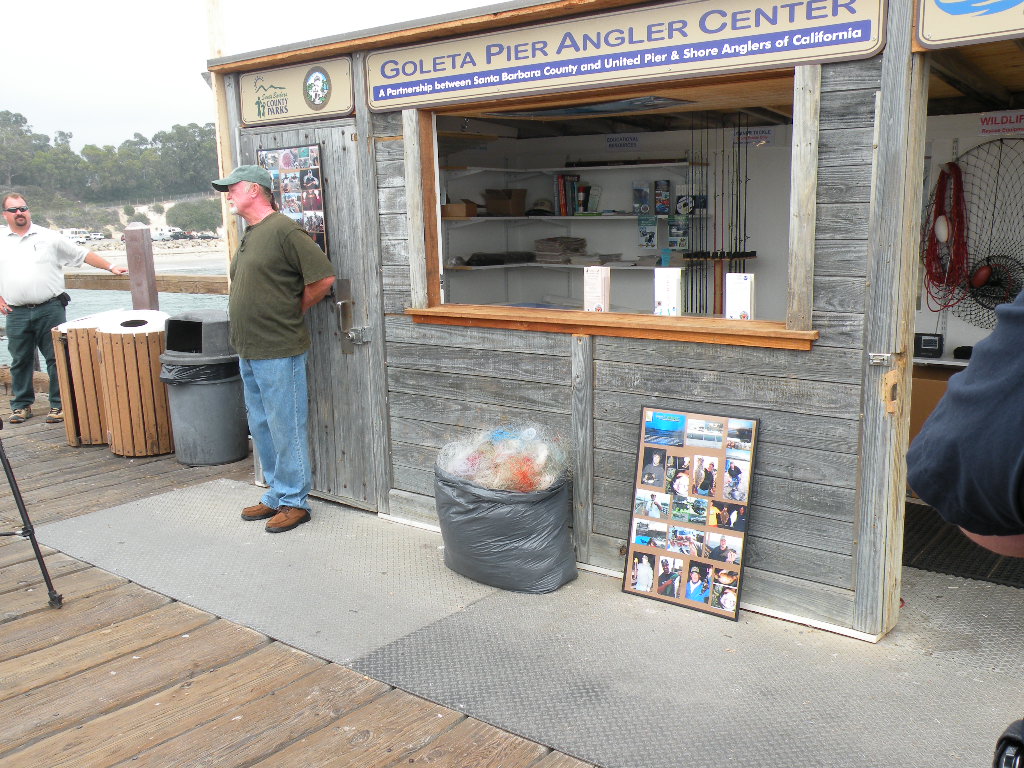
Boyd and the Angler Center
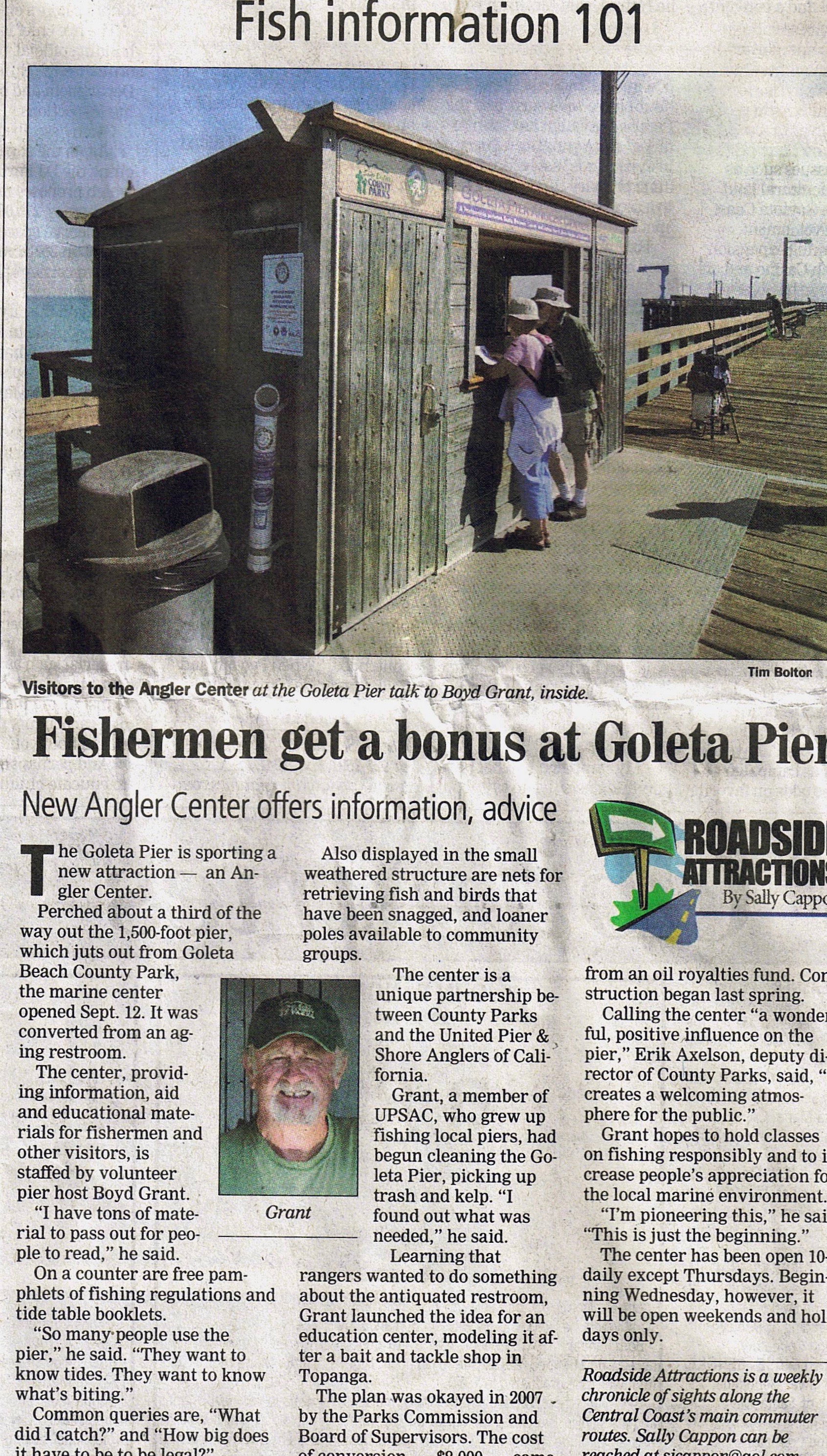
And then, with the establishment of the UPSAC Angler Center at the pier in 2008, he became the official “Pier Host.” He became the eyes and ears of the pier; the man anglers could turn to for advice—including how to properly handle fish and other wildlife at the pier. He became a teacher, advisor, and ultimately a spokesman for the pier. Dozens of kid’s fishing tournament were conducted with his help at the pier. Dozens of injured birds were saved with his help. Untold numbers of anglers changed their views on angling under his gentle tutelage. Visitors and regulars alike gained a new respect for the environment at the pier. And hundreds and hundreds of hours were spent cleaning the pier.
In recognition of his accomplishments, Boyd himself and UPSAC were given recognition by the Santa Barbara Board of Supervisors in November 2010. Among the six stated accomplishments:“Whereas, UPSAC volunteers have staffed the Goleta Pier Angler Center and have provided instructions to over 2,000 children and youth since the Goleta Pier Angler Center was opened…” “Whereas, the Goleta Pier volunteer host, Boyd Grant, in addition to staffing the Angler Center also cleans the handrails and benches of two-thirds of the Goleta Pier.”
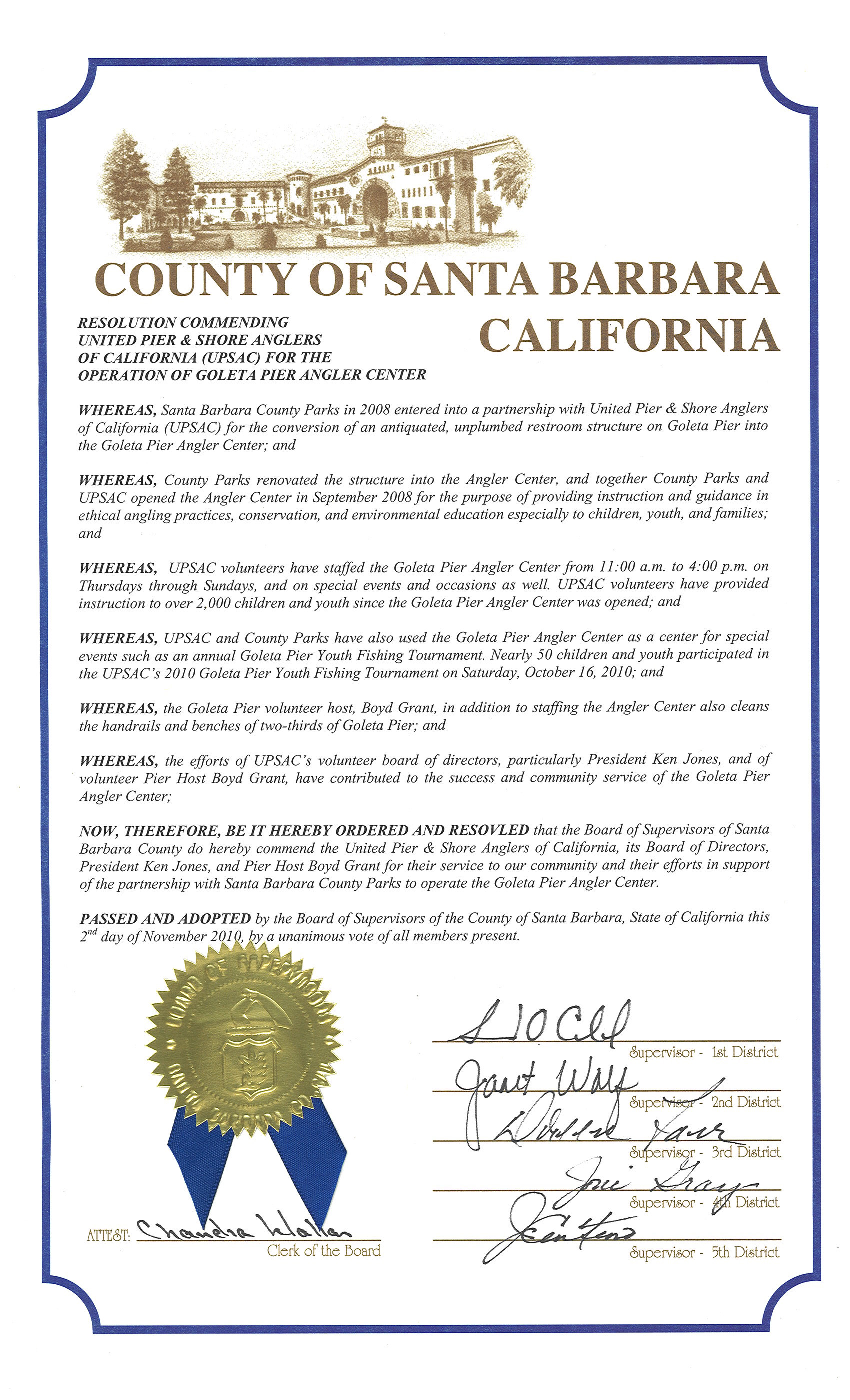 “Therefore, be it hereby ordered and resolved that the Board of Supervisors of Santa Barbara County do hereby commend the United Pier and Shore Anglers of California, its Board of Directors, President Ken Jones, and Pier Host Boyd Grant for their services to our community and their efforts to support of the partnership with Santa Barbara County Parks to operate the Goleta Pier Angler Center.”
“Therefore, be it hereby ordered and resolved that the Board of Supervisors of Santa Barbara County do hereby commend the United Pier and Shore Anglers of California, its Board of Directors, President Ken Jones, and Pier Host Boyd Grant for their services to our community and their efforts to support of the partnership with Santa Barbara County Parks to operate the Goleta Pier Angler Center.”
A dynamic, synergistic effort seemed to be taking place and everyone seemed to be pleased. But as we all know, you can never please all the people all the time. An exodus of top personnel had left the Park District between 2008 and 2011 and new people were now in charge, people with different ideas and a different agenda. Unfortunately that agenda did not include support for Boyd or the Angler Center.
As the time of the 2008 agreement that established his position as Pier Host, Boyd had also agreed to be a Park Host. This allowed him to park his motor home at the park and remain in close proximity to the Angler Center. In exchange, as part of the Park Host Agreement, he was required to spend 20 hours per week cleaning the park. Boyd quickly developed a routine that would begin most mornings at 5AM. Clean the bathrooms, empty trashcans, pick up whatever flotsam and jetsam had been left by late night revelers, and clean the pier (which could be a monumental task in itself). Most days it would take at least three hours and then he would take a break, have a cup of coffee, and take a shower prior to heading out to the Angler Center to begin his duties as Pier Host (where he would typically work another 30-40 hours a week).
Out of necessity, Boyd had begun his day early, far before the rangers arrived at the park. Most respected the hard work and early hours but unfortunately those same hours would be used against him. When UPSAC was informed that Boyd had three weeks to leave the park, the charge was made that Boyd was not working the required 20 hours a week as Park Host (and that part of his hours were being spent on work for the Angler Center). Interviews with those in the know, the locals who visited the pier early in the morning themselves, verified his cleaning and the number of hours he worked. But Park personnel never bothered to interview the locals — and failed to say where they had gotten their information.
As talks continued in an attempt to work out a solution agreeable to both parties, one that would allow Boyd to stay at the Park, and the Angler Center to remain open, the reasons for Boyd’s removal evolved. New arguments were given by the Park personnel. The first was that Park Hosts are supposed to have a one-year limit at a park. After one year hosts have to move on to another park and give up their park position. UPSAC asked why this had never been enforced before? A number of people, including Boyd, had exceeded the one-year time limit. And though UPSAC argued that Boyd’s position was unique—since he was the only Pier Host (at the only park with a pier), and that his unique position justified a close proximity to the pier, the argument fell on deaf ears.
The final argument from the Park personnel was that the Park District was now out of money (although Park personnel seem to have a pretty hefty paycheck). The District’s argument was that the Park would need additional volunteer Park Hosts to maintain the park. They, in turn, would need all the available parking spaces. UPSAC argued that there was sufficient room for Boyd AND additional Park Hosts. UPSAC also argued that the Pier Host position should receive equal respect as the Park Host position. Again the arguments fell on deaf ears.
Given the variety of reasons given for his removal, the fact that these issues changed over the weeks of discussion, and that Boyd himself was never allowed to be part of the discussion (in fact was never given a face to face meeting until the last day when he was told to turn over his keys), it appears that the park personnel simply wanted him out. Why? The most likely reason was that, at times, he could be a thorn in their side. He asked park personnel to give the pier the attention it deserved, to do more at the park. He asked for additional cleaning supplies, he asked for support from management when there were problems at the park, and he refused to become a spokesman for the County Parks when it decided to push for paid parking and other changes he deemed detrimental to the park.
All Boyd wanted was to see people do their job. They perhaps would never have his interest in regards to the pier but at least they should realize that the pier was a key part of the park. This friction was most likely the real reason why he was asked to leave. It’s a problem that can crop up wherever there are moribund agencies that are poorly managed and staffed by poorly trained and motivated employees.
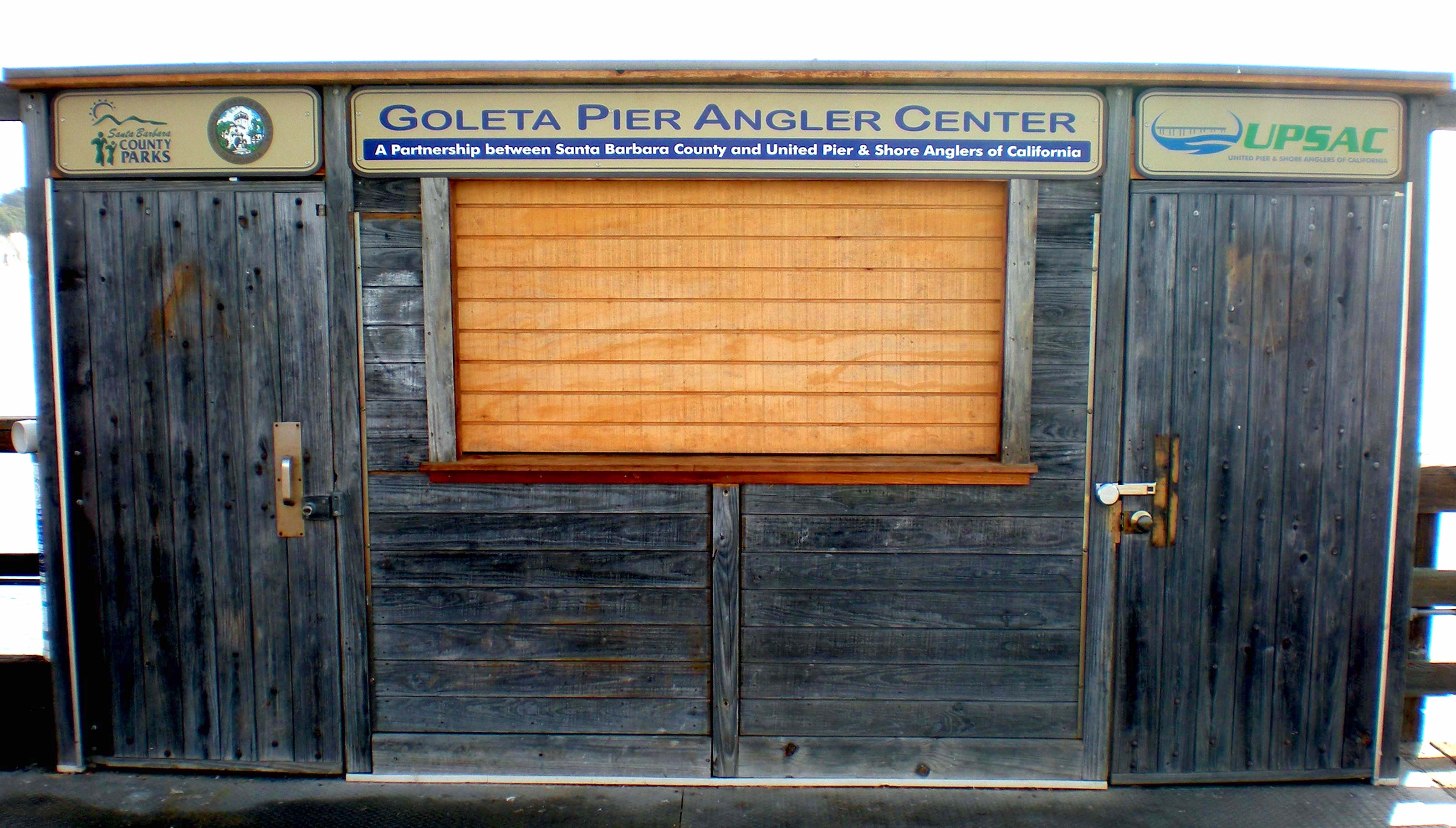
A shuttered Angler Center
It is likely these are the true reasons for his departure and, most likely, the reasons for the end of a dream. Perhaps he simply wanted to do too much. Perhaps there is little room left for those such as Boyd who are willing to sacrifice their personal time and energy to improve a small piece of our society.
Perhaps it is the end of a dream and, if so, not only will the pier and the park itself suffer but so too the entire people of Santa Barbara County. Tis sad.
History Notes. When Juan Cabrillo discovered this coastal spot in 1542, it was the largest “city” in California. It had a population of over 1,000 Canalino Indians who lived on Mescalitan Island (which today sits under the road leading to UCSB). The term “Goleta” by the way, means “schooner” in Spanish and was used as a name for a land grant in 1846. No one is quite sure however if it is so named because of a wreck here of an American schooner or because of a vessel that was built here in 1828/9 by Captain William G. Dana of Nipomo.
The Goleta Slough and Estuary was used as a deep-water port until the floods of 1860-1861 brought down more than fourteen feet of silt; later a whaling station operated on the beach in the 1880s.
In 1874 T. Wallace More who, along with other local ranchers, needed a way to ship his cattle and produce out of Goleta Valley built a wharf on Goleta Beach. As was the practice in those days, the wharf was named after the owner and became More’s Landing. Unfortunately for More, his use of the wharf was short lived. He was murdered by a group of squatters just three years later in 1877. Still, his wharf lived on.
That wharf was 900-foot-long, 35-foot-wide, and reached out into water that was about 11 feet deep at low tide. Shallow, but sufficient for the coastal boats that used it as a port (mostly for shipping the valley’s livestock to the islands, and its farm produce to San Francisco). Competition from the nearby Stearns Wharf in Santa Barbara led to comparable shipping rates for the two wharves. Whenever a coastal steamer would announce its incoming delivery by tooting its whistle three times, the wharf manager would hurry down to the wharf with horse and wagon to unload the incoming goods.
In addition to the farm commodities, over 2,000 tons of asphaltum were sent from the nearby mines (located under today’s UCSB) to pave the streets of San Francisco, as well as those in New Orleans’ Vieux Carre (the famous French Quarter). With the coming of the railroad in 1887 the landing became a railroad wharf. Little remains of those early ventures.
The wharf at least partially collapsed sometime after 1902 but modifications (reconstruction and repair?) are recorded by the Federal Department of Forestry in the late 1920s. The late ‘20s also saw the extension of Fairview Avenue and the construction of a bridge to make the beach accessible to the general public. Soon after, a dressing room and bathhouse were also constructed on the site.
A decade later, in the ‘40s, the sandspit was enlarged which provided the foundation for a park and then, in 1949, the Federal Government granted Goleta Beach to Santa Barbara County. In 1953 the State became the new owner but it then leased the park area back to the County. A reconstruction of the pier took place shortly thereafter, in 1954. In 1970 Goleta Beach was granted back to the County of Santa Barbara.

Goleta Pier in 1972 and 2002
Another reconstruction of the pier took place in the 1980s when it was lengthened (reportedly by 800 feet). The additional length provided room for the launching crane as well as railing space for anglers. A 645-foot rock revetment took place along the main tidal channel into the slough to protect the Park and the restaurant, which was expanded from an existing snack bar in 1982.
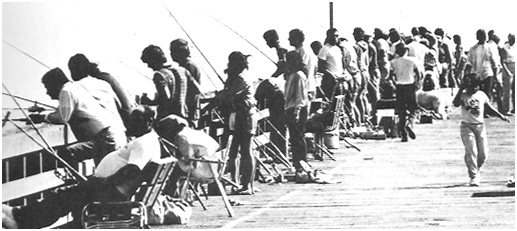
Anglers line the railing in 1984
There also was a time in the ’80s when a sportfishing craft, the sixty-five-foot-long Island Fox operated from the pier. Today, the main boats that operate from the pier are private and university craft launched from the mid-pier sling.
In 1982-83 large El Niño storms decimated much of the kelp in Goleta Bay and eroded much of the beach at the park. Since then there has been a constant fight to replenish the sand culminating in a variety of new plans in the early 2000s to “fix the problem,” As for the kelp forest, it has never been able to reestablish itself (and one of the plans involves trying to do just that in hopes that a vigorous underwater forest would help lessen the currents and waves attacking the beach).
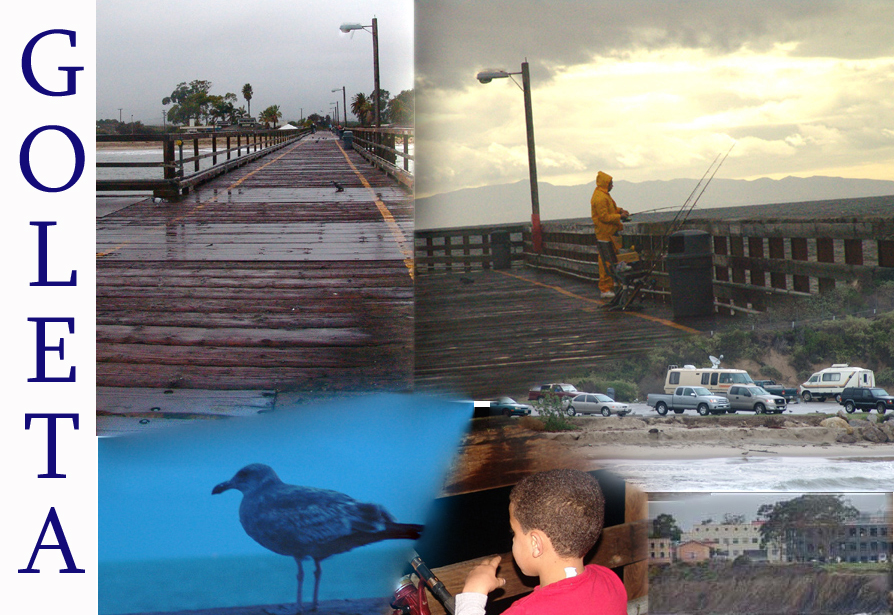
College by Pierhead — 2005
Goleta Pier Facts
Hours: Open 24 hours a day.
Facilities: Lights and fish-cleaning facilities are located on the pier as is a launch sling for small boats. At the foot of the pier, restrooms, a small restaurant and snack bar, and, in some years, a bait and tackle shop are located. Free parking is found near the front of the pier.
Handicapped Facilities: Handicapped parking and restrooms. The pier surface is wood and the rail height is 42 inches. Posted for handicapped.
How To Get There: From Highway 101 take the Hwy. 217/Airport exit. Follow it to Sandspit Rd. and the Goleta Beach Park turnoff. Follow this to the park and the pier.
Management: County Parks Department — Santa Barbara County.
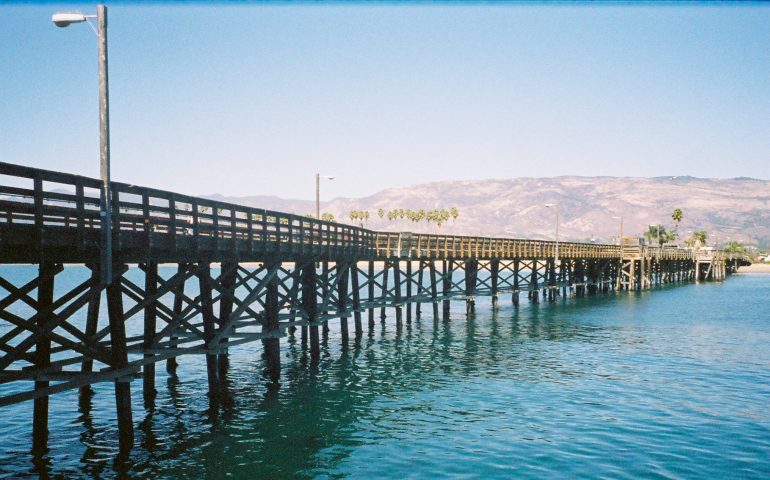
My 91 yr old Dad likes to fish Mon & Thur mornings about mid pier. He believes that since the Last fire & rain runoff, the fishing has been poorer. Any corrollation? Or perhaps its seasonal?
Thanks, Spike
Hello,
Re: Goleta pier.
Will the bait shop be open on august 2 and 3.
Fished Goleta Thursday 8/1. Lots and lots of mackerel, kids loved it! I caught a 13 1/2″ kelpie (arghhhh), using squid and mackerel strips in the kelp. Think there’s a grunion run tonight, lots of people fishing halibut, only saw two very short landed. Overall great day. Bait shop on Pier is open 12-7 daily through September.
Taking my kids to Goleta tomorrow. Will give update on fishing and bait shop status.
Taking sandworms, shrimp, squid, and sardines in case no bait available…
Fished Goleta Thursday 8/1. Lots and lots of mackerel, kids loved it! I caught a 13 1/2″ kelpie (arghhhh), using squid and mackerel strips in the kelp. Think there’s a grunion run tonight, lots of people fishing halibut, only saw two very short landed. Overall great day. Bait shop on Pier is open 12-7 daily through September.
Hello going night fishing at Goleta Pier are the restrooms open? If anyone could answer GREATLY appreciated!
Angela, To be honest I do not know when they lock the restrooms on the pier. They used to be open 24 hours but things always seem to change.
Best wishes and good luck, Ken
Can mackerel be caught year round or is it mostly a summer thing? Surf perch are biting
on mackerel at Guadalupe and Oso Flaco beaches but mack is expensive to buy. Also,
would like to have some on hand for when weather permits getting into the kayak again.
Hello. I have a question. So, at the spot where the artificial reef made by the pipe is located, is there any rockfish left in the area? If anyone could answer, I would greatly appreciate it. Thank you.
There are almost always a number of small brown rockfish.
My family and I fished Goleta last weekend, including the “pipeline reef”, and had no luck with rockfish. We usually catch many of the SBR’s (small brown rockfish) here, but no luck this trip. The best we could manage were several decent sized white croaker. Other than that, pretty slow, not even any mackeral action…did manage to catch a bunch of small kelp crabs in the crab ring though, very entertaining for the kids!